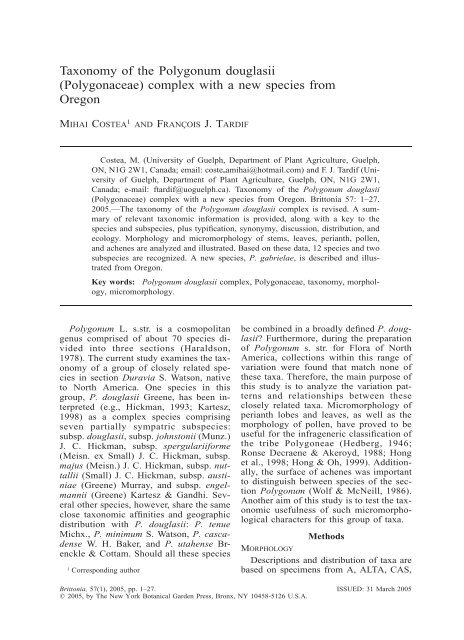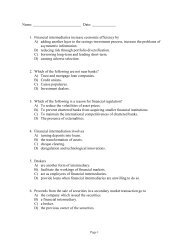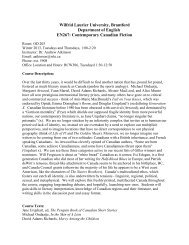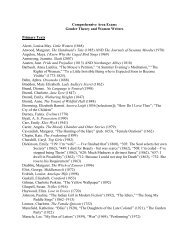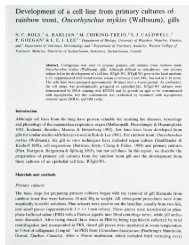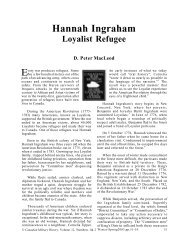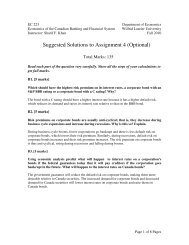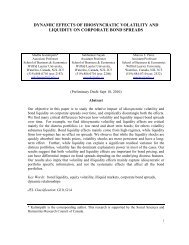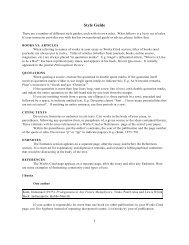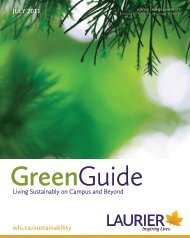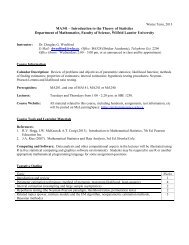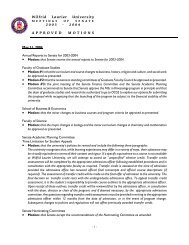Taxonomy of the Polygonum douglasii (Polygonaceae ... - WLU
Taxonomy of the Polygonum douglasii (Polygonaceae ... - WLU
Taxonomy of the Polygonum douglasii (Polygonaceae ... - WLU
Create successful ePaper yourself
Turn your PDF publications into a flip-book with our unique Google optimized e-Paper software.
<strong>Taxonomy</strong> <strong>of</strong> <strong>the</strong> <strong>Polygonum</strong> <strong>douglasii</strong><br />
(<strong>Polygonaceae</strong>) complex with a new species from<br />
Oregon<br />
MIHAI COSTEA 1 AND FRANÇOIS J. TARDIF<br />
Costea, M. (University <strong>of</strong> Guelph, Department <strong>of</strong> Plant Agriculture, Guelph,<br />
ON, N1G 2W1, Canada; email: coste�amihai@hotmail.com) and F. J. Tardif (University<br />
<strong>of</strong> Guelph, Department <strong>of</strong> Plant Agriculture, Guelph, ON, N1G 2W1,<br />
Canada; e-mail: ftardif@uoguelph.ca). <strong>Taxonomy</strong> <strong>of</strong> <strong>the</strong> <strong>Polygonum</strong> <strong>douglasii</strong><br />
(<strong>Polygonaceae</strong>) complex with a new species from Oregon. Brittonia 57: 1–27.<br />
2005.—The taxonomy <strong>of</strong> <strong>the</strong> <strong>Polygonum</strong> <strong>douglasii</strong> complex is revised. A summary<br />
<strong>of</strong> relevant taxonomic information is provided, along with a key to <strong>the</strong><br />
species and subspecies, plus typification, synonymy, discussion, distribution, and<br />
ecology. Morphology and micromorphology <strong>of</strong> stems, leaves, perianth, pollen,<br />
and achenes are analyzed and illustrated. Based on <strong>the</strong>se data, 12 species and two<br />
subspecies are recognized. A new species, P. gabrielae, is described and illustrated<br />
from Oregon.<br />
Key words: <strong>Polygonum</strong> <strong>douglasii</strong> complex, <strong>Polygonaceae</strong>, taxonomy, morphology,<br />
micromorphology.<br />
<strong>Polygonum</strong> L. s.str. is a cosmopolitan<br />
genus comprised <strong>of</strong> about 70 species divided<br />
into three sections (Haraldson,<br />
1978). The current study examines <strong>the</strong> taxonomy<br />
<strong>of</strong> a group <strong>of</strong> closely related species<br />
in section Duravia S. Watson, native<br />
to North America. One species in this<br />
group, P. <strong>douglasii</strong> Greene, has been interpreted<br />
(e.g., Hickman, 1993; Kartesz,<br />
1998) as a complex species comprising<br />
seven partially sympatric subspecies:<br />
subsp. <strong>douglasii</strong>, subsp. johnstonii (Munz.)<br />
J. C. Hickman, subsp. spergulariiforme<br />
(Meisn. ex Small) J. C. Hickman, subsp.<br />
majus (Meisn.) J. C. Hickman, subsp. nuttallii<br />
(Small) J. C. Hickman, subsp. austiniae<br />
(Greene) Murray, and subsp. engelmannii<br />
(Greene) Kartesz & Gandhi. Several<br />
o<strong>the</strong>r species, however, share <strong>the</strong> same<br />
close taxonomic affinities and geographic<br />
distribution with P. <strong>douglasii</strong>: P. tenue<br />
Michx., P. minimum S. Watson, P. cascadense<br />
W. H. Baker, and P. utahense Brenckle<br />
& Cottam. Should all <strong>the</strong>se species<br />
1 Corresponding author<br />
be combined in a broadly defined P. <strong>douglasii</strong>?<br />
Fur<strong>the</strong>rmore, during <strong>the</strong> preparation<br />
<strong>of</strong> <strong>Polygonum</strong> s. str. for Flora <strong>of</strong> North<br />
America, collections within this range <strong>of</strong><br />
variation were found that match none <strong>of</strong><br />
<strong>the</strong>se taxa. Therefore, <strong>the</strong> main purpose <strong>of</strong><br />
this study is to analyze <strong>the</strong> variation patterns<br />
and relationships between <strong>the</strong>se<br />
closely related taxa. Micromorphology <strong>of</strong><br />
perianth lobes and leaves, as well as <strong>the</strong><br />
morphology <strong>of</strong> pollen, have proved to be<br />
useful for <strong>the</strong> infrageneric classification <strong>of</strong><br />
<strong>the</strong> tribe Polygoneae (Hedberg, 1946;<br />
Ronse Decraene & Akeroyd, 1988; Hong<br />
et al., 1998; Hong & Oh, 1999). Additionally,<br />
<strong>the</strong> surface <strong>of</strong> achenes was important<br />
to distinguish between species <strong>of</strong> <strong>the</strong> section<br />
<strong>Polygonum</strong> (Wolf & McNeill, 1986).<br />
Ano<strong>the</strong>r aim <strong>of</strong> this study is to test <strong>the</strong> taxonomic<br />
usefulness <strong>of</strong> such micromorphological<br />
characters for this group <strong>of</strong> taxa.<br />
Methods<br />
MORPHOLOGY<br />
Descriptions and distribution <strong>of</strong> taxa are<br />
based on specimens from A, ALTA, CAS,<br />
Brittonia, 57(1), 2005, pp. 1–27. ISSUED: 31 March 2005<br />
� 2005, by The New York Botanical Garden Press, Bronx, NY 10458-5126 U.S.A.
2 BRITTONIA<br />
[VOL. 57<br />
DAO, DC, DS, GH, F, JEPS, LL, MT,<br />
MTMG, NY, OAC, POM, QFA, RSA,<br />
SASK, TEX, UBC, UC, US, and USAS.<br />
Mature plants with leaves, flowers, and<br />
achenes are necessary for accurate determinations.<br />
Plants parasitized by homopteran<br />
insects are atypical. Their internodes are<br />
shortened, cymes have numerous flowers,<br />
and inflorescences are denser; flowers are<br />
brownish, sterile, and pedicels may be erect<br />
even in taxa in which <strong>the</strong>y are normally reflexed.<br />
Papillae are easily observed on<br />
young stems or toward apices <strong>of</strong> mature<br />
stems and branches, at magnifications higher<br />
than 50�. Measurements <strong>of</strong> leaves and<br />
ocreae were made at <strong>the</strong> middle <strong>of</strong> <strong>the</strong> main<br />
stem. The state characters, ‘‘flowers<br />
closed,’’ ‘‘flowers semiopen,’’ and ‘‘flowers<br />
wide-open’’ were noted on herbarium specimens.<br />
Description <strong>of</strong> perianth refers to <strong>the</strong><br />
fruiting perianth, which was measured from<br />
<strong>the</strong> joint with <strong>the</strong> pedicel. Morphology <strong>of</strong><br />
pedicels was noted in fruit. Measurements<br />
<strong>of</strong> dry an<strong>the</strong>rs were obtained from SEM<br />
pictures (see below).<br />
MICROMORPHOLOGY<br />
Samples (Appendix 1) were collected<br />
from typical herbarium specimens within<br />
<strong>the</strong> holdings <strong>of</strong> CAS, DS, GH, JEPS, NY,<br />
RSA, UC, and USAS. Samples were coated<br />
with 30 nm gold using an Emitech<br />
K550� Sputter Coater and examined with<br />
a Hitachi S-570 at 15 KV. Micromorphology<br />
<strong>of</strong> <strong>the</strong> following organs or plant parts<br />
was examined: mature stems and leaves,<br />
fruiting perianth, and pollen. Surface pattern<br />
<strong>of</strong> perianth was studied on <strong>the</strong> borders<br />
<strong>of</strong> <strong>the</strong> outer perianth lobes. Standard terminology<br />
for cell types and surface sculpturing<br />
patterns follows Ronse Decraene<br />
and Akeroyd (1988), Barthlott et al.<br />
(1998), and Hong et al. (1998). Pollen terminology<br />
follows Hoen (1999). Description<br />
<strong>of</strong> achene morphology and micromorphology<br />
follows <strong>the</strong> terminology developed<br />
by Wolf and McNeill (1986) and<br />
Ronse Decraene et al. (2000).<br />
STEMS<br />
Results<br />
Stems are 4-angled, with smooth (Fig.<br />
1A) or minutely and irregularly ribbed fac-<br />
es (Fig. 1C, D, F). Epidermis cells are rectangular<br />
or elongated, with epicuticular wax<br />
consisting <strong>of</strong> longitudinal rodlets (Fig. 1C).<br />
Stomata are frequent, mostly anisocytic<br />
(rarely a few may be anomocytic). Presence<br />
<strong>of</strong> papillae is a distinctive feature observed<br />
in many taxa. Papillae may be distributed<br />
on <strong>the</strong> stem angles or on <strong>the</strong> ribs and between<br />
<strong>the</strong>se (Fig. 1C, D, F). They may be<br />
patent or more or less retrorse. Papillae<br />
shape varies from � spherical, 7–18 �m,<br />
located at <strong>the</strong> same level with <strong>the</strong> epidermis<br />
cells (Fig. 1A), conical with a swollen base,<br />
40–60 �m (Fig. 1B), to conical-elongated<br />
or cylindrical, 100–200 �m long, approaching<br />
hairs (Fig. 1C, D). Epicuticular wax <strong>of</strong><br />
papillae is organized as parallel rodlets<br />
(Fig. 1B).<br />
LEAVES AND OCREAE<br />
Leaves are obviously jointed to ocreae,<br />
which may be short, funnelform 2–5 mm,<br />
or longer, 5–12 mm, with <strong>the</strong> free part becoming<br />
lacerate or disintegrating into a few<br />
fibers. Petioles are very short or absent.<br />
Blades are variably shaped, linear to round,<br />
and 1-veined. Leaf blade epidermis cells are<br />
irregularly shaped or elongated, with more<br />
or less undulate anticlinal walls. Stomata<br />
are usually present on both epidermis, and<br />
<strong>the</strong>y are mostly anisocytic (rarely a few<br />
may be anomocytic). Margins <strong>of</strong> <strong>the</strong> leaves<br />
are <strong>of</strong>ten revolute (Fig. 2A), or sometimes<br />
plane. In P. utahense, <strong>the</strong> revolute margins<br />
join toge<strong>the</strong>r on <strong>the</strong> abaxial side <strong>of</strong> <strong>the</strong><br />
blade (Fig. 2B). Conical or conical-elongate<br />
papillae, similar to those present on <strong>the</strong><br />
stems, may occur on <strong>the</strong> ocreae and lamina<br />
margins in many taxa (Fig. 1F, 2C, D).<br />
Presence <strong>of</strong> papillae on <strong>the</strong> rest <strong>of</strong> lamina<br />
has been documented only in P. utahense<br />
(Fig. 2B, F) and sometimes in P. spergulariiforme<br />
(Fig. 2E). Epicuticular wax is organized<br />
as longitudinal rodlets or threads<br />
(Fig. 2E); only in P. utahense do <strong>the</strong> rodlets<br />
form a reticulate pattern (Fig. 2F).<br />
PERIANTH<br />
The perianth consists <strong>of</strong> two outer tepals,<br />
one intermediate (transitional), and two inner<br />
tepals fused for 8–40% <strong>of</strong> <strong>the</strong>ir length.<br />
The outer and <strong>the</strong> intermediate perianth
2005] COSTEA & TARDIF: POLYGONUM DOUGLASII COMPLEX<br />
3<br />
FIG. 1. Micromorphology <strong>of</strong> stems. A. <strong>Polygonum</strong> tenue, arrows indicate papillae (scale bar � 100 �m). B.<br />
P. minimum (scale bar � 75 �m). C. P. spergulariiforme (scale bar � 100 �m). D. P. sawatchense subsp.<br />
oblivium (scale bar � 25 �m). E. P. sawatchense subsp. sawatchense (scale bar 50 � mm). F. P. nuttallii (scale<br />
bar � 50 mm).
4 BRITTONIA<br />
[VOL. 57<br />
FIG. 2. Micromorphology <strong>of</strong> leaves. A–D. Margin <strong>of</strong> <strong>the</strong> leaf. A. <strong>Polygonum</strong> sawatchense subsp. sawatchense<br />
(scale bar � 0.3 mm). B. P. utahense (scale bar � 0.3 mm). C. P. sawatchense subsp. oblivium (scale bar<br />
� 100 �m). D. P. spergulariiforme (scale bar � 100 �m). E, F. papillae on <strong>the</strong> leaf blade: E. P. spergulariiforme.<br />
F. P. utahense (scale bars � 30 �m).
2005] COSTEA & TARDIF: POLYGONUM DOUGLASII COMPLEX<br />
5<br />
lobes are oblong-elliptic to oblong-obovate,<br />
<strong>of</strong>ten cucullate and overlapping, naviculate<br />
along <strong>the</strong>ir entire length or only in <strong>the</strong> upper<br />
1/4 (Fig. 3). Vasculature <strong>of</strong> tepals consists<br />
<strong>of</strong> a single vein, which may be<br />
branched or not.<br />
EPICUTICULAR WAX PATTERN OF PERIANTH<br />
LOBES<br />
Epidermis cells are irregularly shaped,<br />
elongated or rectangular (Figs. 4, 5). Stomata<br />
are usually present. The anticlinal<br />
walls are usually sinuate or sometimes<br />
straight or weakly undulate (Figs. 4, 5).<br />
Epicuticular wax sculpture pattern is variable<br />
and complex:<br />
Type 1. Epidermis cells with <strong>the</strong> periclinal<br />
walls more or less flat. Sculpture pattern<br />
is homogenous on <strong>the</strong> same cell. Wax<br />
rodlets may be arranged in a dense reticulate,<br />
intertwined pattern (Figs. 4C, 5E,<br />
F) or <strong>the</strong>y may be more or less transversally<br />
oriented (Fig. 4A, B).<br />
Type 2. Epidermis cells with <strong>the</strong> periclinal<br />
walls evidently convex. Sculpture pattern<br />
is heterogeneous on <strong>the</strong> same cell: wax<br />
rodlets are � parallel among <strong>the</strong>mselves<br />
and perpendicular to <strong>the</strong> long axis <strong>of</strong><br />
cells on <strong>the</strong> lateral inclined faces and arranged<br />
in a dense reticulate and intertwined<br />
pattern on <strong>the</strong> more or less flat top<br />
<strong>of</strong> <strong>the</strong> periclinal walls (Fig. 4D–F, 5A–<br />
D).<br />
STAMENS<br />
Stamens are most commonly eight, arranged<br />
in two ‘‘whorls.’’ The outer whorl<br />
consists <strong>of</strong> five stamens and <strong>the</strong> inner <strong>of</strong><br />
three stamens. Stamens in <strong>the</strong> outer<br />
‘‘whorl’’ may be reduced, sometimes entirely<br />
(e.g., P. sawatchense subsp. sawatchense).<br />
The base <strong>of</strong> <strong>the</strong> inner stamens is<br />
thickened and associated with a nectarial<br />
tissue. An<strong>the</strong>rs are short, 100–550 �m, pink<br />
to purple, rarely whitish.<br />
POLLEN<br />
The pollen belongs to <strong>the</strong> ‘‘Duravia<br />
type’’ described by Hedberg (1946). It is<br />
prolate, usually tricolporate with <strong>the</strong> exine<br />
semitectate-reticulate or microreticulate at<br />
<strong>the</strong> mesocolpia and poles, and microreticulate-foveolate<br />
or sometimes foveolate<br />
with microspinules around ectoapertures<br />
(Fig. 6). Two distinct types can be recognized<br />
based <strong>the</strong> size <strong>of</strong> <strong>the</strong> pollen grains,<br />
<strong>the</strong> reticulum sculpturing at <strong>the</strong> middle part<br />
<strong>of</strong> <strong>the</strong> mesocolpium and <strong>the</strong> sculpturing <strong>of</strong><br />
ectoapertures:<br />
Type A. Pollen grains 20–26 �m long; mesocolpium<br />
is microreticulate with 1–7<br />
rows <strong>of</strong> lumina, 0.5–1(–1.1) �m indiameter,<br />
clearly differentiated or undifferentiated<br />
from <strong>the</strong> ectoapertures, which<br />
are microreticulate to tectate perforate,<br />
foveolate-punctate, sometimes with microspinules.<br />
● Subtype A1.—Mesocolpium is microreticulate<br />
and not clearly differentiated<br />
from <strong>the</strong> ectoapertures. Mesocolpium microreticulum<br />
with 4–7 rows <strong>of</strong> lumina,<br />
0.5–0.9 �m in diameter (Fig. 6A–C).<br />
● Subtype A2.—Mesocolpium is reticulate,<br />
clearly differentiated from ectoapertures.<br />
Mesocolpium reticulum with 1–<br />
5 rows <strong>of</strong> lumina, 0.9–1.1 �m in diameter<br />
(Fig. 6D, E).<br />
Type B. Pollen grains 28–33 �m; mesocolpium<br />
is reticulate with 1–2 rows <strong>of</strong> lumina,<br />
1.5–4 �m in diameter; mesocolpium<br />
is sharply differentiated from <strong>the</strong><br />
ectoapertures, which are tectate imperforate,<br />
rarely punctate, with a few puncta<br />
(Fig. 6F–H).<br />
ACHENES<br />
Achenes are black, trigonous, ovate,<br />
ovate-lanceolate, elliptic, and enclosed in<br />
<strong>the</strong> perianth or exserted at maturity (Fig. 7).<br />
Faces are concave and subequal; one face<br />
is slightly broader than <strong>the</strong> o<strong>the</strong>r two (Fig.<br />
7). The exocarp is usually lustrous and<br />
smooth, or sometimes it may be striate-tubercled,<br />
especially near <strong>the</strong> edges and apex<br />
<strong>of</strong> achenes (Fig. 7C, F). Tubercles may be<br />
arranged in longitudinal rows, more or less<br />
following <strong>the</strong> anticlinal walls (Fig. 7D).<br />
<strong>Taxonomy</strong><br />
Hickman (1984) included within P.<br />
<strong>douglasii</strong> five o<strong>the</strong>r species that share a significant<br />
area <strong>of</strong> sympatry: P. sawatchense
6 BRITTONIA<br />
[VOL. 57<br />
FIG. 3. Morphology <strong>of</strong> flowers. A. <strong>Polygonum</strong> <strong>douglasii</strong>. B. P. sawatchense subsp. oblivium. C. P. nuttallii.<br />
D. and E. P. gabrielae. F. P. sawatchense subsp. sawatchense. G. P. utahense. H. P. cascadense. I. P. engelmannii.<br />
J. P. austiniae. Scale bars � 1 mm.
2005] COSTEA & TARDIF: POLYGONUM DOUGLASII COMPLEX<br />
7<br />
FIG. 4. Epicuticular wax sculpture pattern <strong>of</strong> perianth lobes. A. <strong>Polygonum</strong> tenue. B. P. <strong>douglasii</strong>. C. P.<br />
sawatchense subsp. sawatchense. D. P. sawatchense subsp. oblivium. E. P. spergulariiforme. F. P. majus. Scale<br />
bars � 20 �m.
8 BRITTONIA<br />
[VOL. 57<br />
FIG. 5. Epicuticular wax sculpture pattern <strong>of</strong> perianth lobes. A. <strong>Polygonum</strong> austiniae. B. P. utahense. C. P.<br />
engelmannii. D. P. gabrielae. E. P. minimum. F. P. nuttallii. Scale bars � 20 �m.
2005] COSTEA & TARDIF: POLYGONUM DOUGLASII COMPLEX<br />
9<br />
FIG. 6. Morphology <strong>of</strong> pollen. A. P. <strong>douglasii</strong>. B. P. tenue. C. P. sawatchense subsp. sawatchense. D. P.<br />
sawatchense subsp. oblivium. E. P. minimum (scale bars � 5 �m). F. P. nuttallii (scale bar � 4 �m). G. P.<br />
gabrielae. H. P. majus (scale bar � 4 �m).
10 BRITTONIA<br />
[VOL. 57<br />
FIG. 7. Morphology and micromorphology <strong>of</strong> achenes. A. <strong>Polygonum</strong> sawatchense subsp. sawatchense. B.<br />
P. sawatchense subsp. oblivium. C. P. tenue. D. P. <strong>douglasii</strong>. E. P. majus. F. P. spergulariiforme. G. P. austiniae.<br />
H. P. engelmannii. I. P. gabrielae. J. P. utahense. Scale bar � 1 mm for all figures except Figure 7D where<br />
scale bar is 100 �m.
2005] COSTEA & TARDIF: POLYGONUM DOUGLASII COMPLEX<br />
11<br />
Small, P. spergulariiforme Meisn. ex<br />
Small, P. majus Meisn., P. nuttallii Small,<br />
and P. austiniae Greene. He justified <strong>the</strong>se<br />
new combinations by <strong>the</strong> intermediate patterns<br />
<strong>of</strong> variation between some <strong>of</strong> <strong>the</strong> taxa.<br />
A sixth species, P. engelmannii Greene was<br />
put in synonymy under P. <strong>douglasii</strong> based<br />
on a previous observation that <strong>the</strong> two taxa<br />
are closely related (Hitchcock, 1964) and<br />
because ‘‘<strong>the</strong> distinction <strong>of</strong> <strong>the</strong>se two taxa<br />
is not always clear’’ (Kartesz & Gandhi,<br />
1990). The majority <strong>of</strong> collections annotated<br />
as ‘‘intermediates’’ by Hickman (in<br />
CAS, DS, JEPS, RSA, and UC) are ei<strong>the</strong>r<br />
between ‘‘P. <strong>douglasii</strong> subsp. <strong>douglasii</strong> and<br />
subsp. johnstonii’’ (P. <strong>douglasii</strong> and P. sawatchense<br />
subsp. sawatchense, respectively)<br />
or between P. <strong>douglasii</strong> and P. spergulariiforme.<br />
Most <strong>of</strong> <strong>the</strong>se ‘‘intermediates’’<br />
are, in our opinion, within <strong>the</strong> range <strong>of</strong> variation<br />
<strong>of</strong> each taxon, which has been poorly<br />
understood. In <strong>the</strong> first case, plants regarded<br />
by Hickman as intermediates between<br />
‘‘subsp. <strong>douglasii</strong> and subsp. johnstonii’’<br />
are ei<strong>the</strong>r P. <strong>douglasii</strong> or P. sawatchense<br />
subsp. sawatchense (Costea & Tardif,<br />
2003a). In <strong>the</strong> second case, most <strong>of</strong> <strong>the</strong><br />
plants considered by Hickman intermediates<br />
between P. <strong>douglasii</strong> and P. spergulariiforme<br />
belong, in our opinion, to P. majus.<br />
In most <strong>of</strong> <strong>the</strong> situations encountered,<br />
plants can be assigned to each species using<br />
qualitative or quantitative characters. Hybridization<br />
may have played a role in <strong>the</strong><br />
evolution <strong>of</strong> this group <strong>of</strong> species, but <strong>the</strong><br />
relatively low levels <strong>of</strong> introgression observed<br />
do not warrant <strong>the</strong>ir combination in<br />
a single species. The close relationship between<br />
<strong>the</strong>se taxa does not justify a cumbersome<br />
species concept <strong>of</strong> P. <strong>douglasii</strong>, to<br />
which should also be added following <strong>the</strong><br />
same criterion even more species: P. minimum,<br />
P. cascadense, and P. utahense, as<br />
well as a previously undescribed species, P.<br />
gabrielae. This is not <strong>the</strong> same situation<br />
within <strong>the</strong> P. aviculare L. complex, where<br />
taxa are linked by a continuum transition <strong>of</strong><br />
variation patterns, which makes <strong>the</strong>ir recognition<br />
at species rank unrealistic (Costea<br />
& Tardif, 2003b). Consequently, a species<br />
concept closer to that <strong>of</strong> Small (1895) and<br />
Hitchcock (1964) is followed here (see also<br />
<strong>the</strong> discussions under each species).<br />
This group <strong>of</strong> species is probably monophyletic<br />
and may be worth recognizing as<br />
a subsection <strong>of</strong> <strong>the</strong> section Duravia (emended<br />
by Hedberg, 1946). Hickman (1984) elevated<br />
Duravia to <strong>the</strong> subgenus rank and<br />
separated from it a new section, Monticola,<br />
in which he included <strong>the</strong> species <strong>of</strong> <strong>the</strong> P.<br />
<strong>douglasii</strong> and P. polygaloides complexes.<br />
According to this classification, section Duravia<br />
incorporates species from lowland<br />
and foothill locations, with leaves not obviously<br />
jointed to ocreae, linear, 3-nerved<br />
(rarely 1-nerved), mucronate apex and<br />
styles separate, hardened, and persistent at<br />
least at <strong>the</strong> base. In contrast, Monticola includes<br />
species from montane areas, with<br />
leaves obviously jointed to ocreae, apex not<br />
mucronate, at least lowest leaves lanceolate<br />
to round and styles, that are fused at base<br />
and nei<strong>the</strong>r hardened nor persistent (Hickman,<br />
1984). However, we found a considerable<br />
overlap between Duravia and Monticola<br />
in <strong>the</strong>se characters. Additionally,<br />
some species from Duravia cannot be classified<br />
in any <strong>of</strong> <strong>the</strong> two sections (e.g., P.<br />
shastense Brewer ex A. Gray and P. paronychia<br />
Cham. & Schlecht.). Therefore, in<br />
this study, section Duravia is interpreted to<br />
include section Monticola. The latter section,<br />
circumscribed here to include only <strong>the</strong><br />
species <strong>of</strong> P. <strong>douglasii</strong> complex, may be accepted<br />
after fur<strong>the</strong>r study as a subsection <strong>of</strong><br />
Duravia. Some authors (Ronse Decraene &<br />
Akeroyd, 1988; Ronse Decraene et al.,<br />
2000) suggested that even section Duravia<br />
is artificial because <strong>of</strong> <strong>the</strong> partial overlap in<br />
floral and fruit characters between some <strong>of</strong><br />
its species and <strong>the</strong> section <strong>Polygonum</strong>. Although<br />
section Duravia is heterogeneous<br />
and shares some features with section <strong>Polygonum</strong><br />
(Ronse Decraene & Akeroyd,<br />
1988; Ronse Decraene et al., 2000), <strong>the</strong><br />
morphology <strong>of</strong> stems, color <strong>of</strong> an<strong>the</strong>rs, venation<br />
pattern, structure <strong>of</strong> petioles (Haraldson,<br />
1978), and morphology <strong>of</strong> pollen<br />
(Hedberg, 1946) clearly separates <strong>the</strong> two<br />
sections.
12 BRITTONIA<br />
[VOL. 57<br />
Key to <strong>the</strong> <strong>Polygonum</strong> <strong>douglasii</strong> complex<br />
1. Pedicels patent or erect.<br />
2. Leaves with one pleat on each side <strong>of</strong> <strong>the</strong> midvein --------------------------------------------------------------------------------- P. tenue<br />
2. Leaves not pleated.<br />
3. Ocreae 1–4 mm long, funnelform; perianth 1.8–2.5 mm long; achenes 1.8–2.3 mm long.<br />
4. Plants 1.5–3.5 cm tall; leaves and bracts uniformly papillose, cylindrical due to revolute margins<br />
that join toge<strong>the</strong>r on <strong>the</strong> abaxial face ---------------------------------------------------------------------------------------- P. utahense<br />
4. Plants 3–50 cm tall; leaves and bracts glabrous or papillose only on <strong>the</strong> margins; leaves plane<br />
or with narrow revolute margins, which are never joined toge<strong>the</strong>r on <strong>the</strong> abaxial face.<br />
5. Plants glabrous; flowers wide-open ------------------------------------------------------------------------------------ P. cascadense<br />
5. Plants papillose-scaberulous at least on <strong>the</strong> ocreae; flowers closed or semiopen.<br />
6. Leaves elliptic, obovate to subround, pure green adaxially, margins plane or narrowly<br />
revolute, irregularly thickened or denticulate-papillose; an<strong>the</strong>rs 120–165 �m long ----<br />
-------------------------------------------------------------------------------------------------------------------------------------------- P. minimum<br />
6. Leaves linear to narrow elliptic, � glaucescent adaxially, margins revolute, smooth;<br />
an<strong>the</strong>rs 250–325 �m long ---------------------------------------------------------------------------------------------- P. nuttallii<br />
3. Ocreae 4–12 mm long, not funnelform; perianth 3–5 mm long; achenes 2.5–5 mm long.<br />
7. Inflorescence dense, cymes crowded and overlapping at stem and branch apices; an<strong>the</strong>rs<br />
400–550 �m long ---------------------------------------------------------------------------------------------------- P. spergulariiforme<br />
7. Inflorescence open, cymes regularly spaced along stem and branches; an<strong>the</strong>rs 130–200 �m<br />
long ----------------------------------------------------------------------------------------------------------------------------------- P. sawatchense<br />
8. Stems and ocreae glabrous; leaf blades linear to linear-lanceolate, smooth on <strong>the</strong> margins.<br />
-------------------------------------------------------------------------------------------------- P. sawatchense subsp. sawatchense<br />
8. Stems and ocreae scaberulous-papillose; leaf blades elliptic or elliptic-lanceolate, denticulate-papillose<br />
on <strong>the</strong> margins --------------------------------------------- P. sawatchense subsp. oblivium<br />
1. Pedicels reflexed.<br />
9. Ocreae 6–12 mm long; flowers and achenes 3–5 mm long.<br />
10. Flowers wide-open or semiopen; pedicels 0.5–1 mm long; perianth tube 9–17% <strong>of</strong> <strong>the</strong><br />
perianth length; an<strong>the</strong>rs 400–550 �m long -------------------------------------------------------------------------- P. majus<br />
10. Flowers mostly closed; pedicels 2–6 mm long; perianth tube 20–28% <strong>of</strong> <strong>the</strong> perianth length;<br />
an<strong>the</strong>rs 125–150 �m long ------------------------------------------------------------------------------------------------- P. <strong>douglasii</strong><br />
9. Ocreae 3–5 mm long; flowers and achenes 2–3 mm long.<br />
11. Inflorescence dense, cymes overlapping at stem and branch apices; flowers wide-open, with<br />
<strong>the</strong> tube 10–15% <strong>of</strong> <strong>the</strong> perianth length; an<strong>the</strong>rs 325–380 �m long ------------------------ P. gabrielae<br />
11. Inflorescence elongated, spike-like, cymes spaced along stem and branches; flowers closed,<br />
with <strong>the</strong> tube 25–33% <strong>of</strong> <strong>the</strong> perianth length; an<strong>the</strong>rs 100–160 �m long.<br />
12. Tip <strong>of</strong> mature achene exserted from perianth; lower leaves linear-oblanceolate with<br />
smooth margins ---------------------------------------------------------------------------------------------------- P. engelmannii<br />
12. Tip <strong>of</strong> mature fruit enclosed in perianth; lower leaves broadly elliptic to ovate, with<br />
margins minutely denticulate-papillose ----------------------------------------------------------------- P. austiniae<br />
1. POLYGONUM TENUE Michx., Fl. Bor.<br />
Amer. 1: 238. 1803. TYPE: CANADA.<br />
‘‘Herbier de l’Amérique septentrionale.<br />
In Canada, at Mona Caesarea ad Snake<br />
Bill,’’ Michaux s.n. (LECTOTYPE, here designated:<br />
P, specimens on left side <strong>of</strong><br />
sheet).<br />
<strong>Polygonum</strong> tenue var. protrusum Fernald, Rhodora<br />
44: 393. 1942. TYPE: United States. Virginia.<br />
Southhampton Co.: Blackwater River, SE <strong>of</strong> Ivor,<br />
16 Oct 1941, Fernald & Long 13937 (HOLOTYPE:<br />
GH; isotypes: NY, US).<br />
Annual herbs. Stems 5–50 cm long, 4–<br />
angled, green or brownish, erect, simple or<br />
branched, with a few to many branches, upper<br />
edges glabrous, � winged or denticulate-papillose;<br />
papillae on <strong>the</strong> edges (when<br />
present) conical, 80–120 �m, papillae on<br />
<strong>the</strong> stem faces spherical, 7–18 �m, located<br />
at <strong>the</strong> same level with <strong>the</strong> epidermis cells<br />
(Fig. 1A). Leaves: basal leaves caducous or<br />
persistent at flowering; upper leaves reduced<br />
to scale-like bracts upward; ocreae<br />
6–15 mm, glabrous, free part soon disintegrating<br />
into a few brown fibers; blades narrowly<br />
lanceolate to linear, with 2 deep<br />
pleats parallel to <strong>the</strong> midvein, 25–40 � 1–<br />
8 mm, margins usually plane, denticulatepapillose,<br />
apex mucronate or cuspidate. Papillae<br />
on leaf margins conic-elongated or<br />
cylindrical, 110–200 �m. Inflorescences<br />
terminal, spike-like, slender and elongated;<br />
cymes 1 or 2(3)-flowered, widely spaced<br />
along stem and branches; bracts shorter to<br />
equaling <strong>the</strong> flowers <strong>the</strong>y subtend. Flowers<br />
closed; pedicels erect, 1–1.5 mm; perianth
2005] COSTEA & TARDIF: POLYGONUM DOUGLASII COMPLEX<br />
13<br />
2.5–4.2 mm, <strong>the</strong> tube 15–22% <strong>of</strong> <strong>the</strong> perianth<br />
length, perianth lobes petaloid or sepaloid,<br />
cucullate, naviculate, overlapping,<br />
green (<strong>of</strong>ten brownish when dried), with<br />
pink or white borders; perianth lobe cells<br />
rectangular, 33–45 � 18–22 �m, with <strong>the</strong><br />
anticlinal walls straight; epicuticular wax<br />
pattern <strong>of</strong> type 1, with a transversal pattern<br />
<strong>of</strong> rodlets (Fig. 4A). Stamens 8, with pink<br />
or purple an<strong>the</strong>rs, 125–150 �m long. Pollen<br />
<strong>of</strong> subtype A1, 21–24 �m (Fig. 6B).<br />
Achenes elliptic to oblong, 2.3–4 mm, included<br />
in <strong>the</strong> perianth or slightly exserted<br />
at maturity, smooth or minutely striate-tubercled<br />
near <strong>the</strong> edges and apex (Fig. 7C).<br />
2n � 20 (Löve & Löve, 1956).<br />
Löve and Löve (1956) reported that <strong>the</strong>y<br />
obtained fertile hybrids from crosses between<br />
P. tenue and P. <strong>douglasii</strong>. This study<br />
was criticized and its results disregarded because<br />
authors did not cite any vouchers and<br />
because some chromosome counts were<br />
doubtful (e.g., Mertens & Raven, 1965;<br />
Wolf & McNeill, 1987). However, P. tenue<br />
is hardly mistakable with any o<strong>the</strong>r <strong>Polygonum</strong><br />
species because <strong>of</strong> its peculiar leaf<br />
morphology. This is <strong>the</strong> only species <strong>of</strong> <strong>the</strong><br />
section Duravia that has evolved in central<br />
and eastern North America. Its geographical<br />
distribution (see below) extends westwards<br />
to Wyoming and overlaps in part<br />
with that <strong>of</strong> P. <strong>douglasii</strong> and P. sawatchense<br />
subsp. sawatchense. Morphologically<br />
and micromorphologically <strong>the</strong> three taxa<br />
are similar. They have <strong>the</strong> A1-subtype <strong>of</strong><br />
pollen grains and perianth lobes with epicuticular<br />
wax organized as transversally<br />
oriented rodlets. All evidence indicates that<br />
P. tenue, P. sawatchense, and P. <strong>douglasii</strong><br />
may connect section Duravia to section <strong>Polygonum</strong>.<br />
Two geographically distinct collections<br />
<strong>of</strong> P. tenue are mounted on <strong>the</strong> type sheet.<br />
The left group <strong>of</strong> specimens are from Canada.<br />
Because <strong>the</strong>y are mature and more numerous,<br />
<strong>the</strong>y are here designated as a lectotype.<br />
The collections from <strong>the</strong> right are<br />
from <strong>the</strong> United States, ‘‘stam. 7, stili 3, in<br />
pratensibus Illinoesimum.’’ They are immature<br />
but easily recognizable by <strong>the</strong> morphology<br />
<strong>of</strong> <strong>the</strong> leaves.<br />
Distribution and ecology. Canada (sou<strong>the</strong>rn<br />
Ontario) and <strong>the</strong> United States (Ala-<br />
bama, Arkansas, Connecticut, Delaware,<br />
District <strong>of</strong> Columbia, Georgia, Illinois, Indiana,<br />
Iowa, Kansas, Kentucky, Louisiana,<br />
sou<strong>the</strong>rn Maine, Maryland, Massachusetts,<br />
sou<strong>the</strong>rn Michigan, sou<strong>the</strong>rn Minnesota,<br />
Missouri, Nebraska, New Hampshire, New<br />
Jersey, New York, western North Carolina,<br />
Ohio, Oklahoma, Pennsylvania, Rhode Island,<br />
South Dakota, Tennessee, eastern Texas,<br />
Vermont, Virginia, West Virginia, sou<strong>the</strong>rn<br />
Wisconsin, and Wyoming). It grows on<br />
dry, sandy, acid soils, in exposed locations.<br />
Phenology. Flowering June–October.<br />
2. POLYGONUM DOUGLASII Greene, Bull. Calif,<br />
Acad. Sci. 1: 125. 1885. TYPE: UNIT-<br />
ED STATES. California. Tulare Co.:<br />
Coyote Creek, 30 Jul 1904, Culberson<br />
4391 (NEOTYPE designated by Hickman<br />
1984: DS; ISONEOTYPE: NDG).<br />
<strong>Polygonum</strong> tenue var. latifolium Engelm. in A. Gray,<br />
Proc. Acad. Nat. Sci. Philadelphia 1863: 75.<br />
1863. <strong>Polygonum</strong> <strong>douglasii</strong> var. montanum Small,<br />
Mem. Dept. Bot. Columbia Coll. 1: 118. 1895.<br />
<strong>Polygonum</strong> <strong>douglasii</strong> var. latifolium (Engelm. ex<br />
A. Gray) Greene, Bull. Calif. Acad. Sci. 1: 125.<br />
1885. <strong>Polygonum</strong> montanum (Small) Greene, Pl.<br />
Baker. 3: 13. 1901. TYPE: not designated.<br />
<strong>Polygonum</strong> emaciatum A. Nelson, Bot. Gaz. 54:<br />
138. 1912. TYPE: UNITED STATES. Idaho. Gem<br />
Co.: ‘‘doby’’ lava slopes, near Sweet, 14 Aug<br />
1911, MacBride 1692 (LECTOTYPE, here designated:<br />
RM; ISOLECTOTYPES: GH, US, WS–n.v.<br />
Annual herbs. Stems 5–80 cm long, 4angled,<br />
green, erect to ascendent, simple to<br />
freely branched from below <strong>the</strong> middle, glabrous<br />
with smooth faces, or angles with<br />
sparse papillae; papillae conical, 40–60 �m<br />
long. Leaves: basal leaves usually caducous<br />
or persistent at flowering, upper leaves<br />
abruptly reduced to scale-like bracts; ocreae<br />
6–12 mm, glabrous or sparsely scaberulouspapillose,<br />
with <strong>the</strong> free part hyaline, lacerate;<br />
leaf blades linear, narrow-oblong, oblanceolate<br />
to oblong, 15–55 � 2–8(–12)<br />
mm, margins smooth or denticulate-papillose;<br />
apex acute or mucronate. Papillae on<br />
ocreae and leaf margins are similar to those<br />
on <strong>the</strong> stems, or <strong>the</strong>y may be conic-cylindrical,<br />
60–85 �m long. Inflorescences terminal,<br />
elongated and spike-like; cymes 2–<br />
4-flowered, regularly spaced along <strong>the</strong> stem<br />
and branches; bracts equaling or somewhat<br />
longer than <strong>the</strong> flowers. Flowers closed;
14 BRITTONIA<br />
[VOL. 57<br />
pedicels reflexed, 2–6 mm; perianth 3–4.5<br />
mm, <strong>the</strong> tube 20–28% <strong>of</strong> <strong>the</strong> perianth<br />
length, perianth lobes petaloid or sepaloid,<br />
cucullate, naviculate, overlapping, tannish<br />
to green, margins white or pink, midveins<br />
usually branched, rarely unbranched (Fig.<br />
3A); perianth lobe cells rectangular 30–60<br />
� 9–15 �m with anticlinal walls straight or<br />
weekly sinuate; epicuticular wax pattern belongs<br />
to type 1 and has transversally reticulate<br />
rodlets (Fig. 4B). Stamens 6–8; an<strong>the</strong>rs<br />
pink to purple, 125–150 �m long. Pollen<br />
<strong>of</strong> subtype A1, 22–24 �m (Fig. 6A).<br />
Achenes elliptic, oblong to ovate, 3–4(–<br />
4.5) mm, enclosed in <strong>the</strong> perianth at maturity,<br />
smooth or tubercled.<br />
Greene (1885) described P. <strong>douglasii</strong> var.<br />
latifolium with ‘‘saw-too<strong>the</strong>d,’’ oblong<br />
blades, and oblong achenes, as opposed to<br />
var. <strong>douglasii</strong> having linear-lanceolate to<br />
lanceolate or oblanceolate, glabrous leaves,<br />
and ovate achenes. This variety has been<br />
accepted by Hitchcock (1964), but <strong>the</strong> authors<br />
abandoned <strong>the</strong> leaf margin and achene<br />
shape characters. Indeed, we have encountered<br />
P. <strong>douglasii</strong> plants with narrow-lanceolate<br />
leaves having denticulate-papillose<br />
margins, as well as plants with glabrous oblong<br />
leaves. Achene shape also varies from<br />
elliptic to oblong or ovate, with no relation<br />
to <strong>the</strong> blade width. Although plants with<br />
wide leaves tend to occur more frequently<br />
at higher altitudes, leaf shape varies continuously,<br />
and <strong>the</strong> two varieties cannot be satisfactorily<br />
separated. Plants with broad<br />
leaves bring P. <strong>douglasii</strong> close to P. austiniae<br />
and to P. sawatchense subsp. oblivium.<br />
In fact, Hickman (in herb.) regarded such<br />
plants as intermediates between P. <strong>douglasii</strong><br />
‘‘subsp. johnstonii (P. sawatchense<br />
subsp. sawatchense) and subsp. <strong>douglasii</strong>.’’<br />
However, P. <strong>douglasii</strong> is readily distinguished<br />
from P. austiniae by its bigger<br />
flowers and achenes. From P. sawatchense<br />
subsp. oblivium it differs by <strong>the</strong> glabrous<br />
stems, reflexed achenes, and <strong>the</strong> pollen <strong>of</strong><br />
subtype A1. From both taxa, it is distinguished<br />
by <strong>the</strong> epicuticular wax sculpture<br />
<strong>of</strong> perianth lobes with transversally reticulate<br />
rodlets.<br />
Distribution and ecology. Canada (Alberta,<br />
British Columbia, Saskatchewan,<br />
Manitoba, Ontario, and Québec) and <strong>the</strong><br />
United States (Arizona, California, Colorado,<br />
Idaho, Maine, Maryland, Michigan,<br />
Minnesota, Montana, Nebraska, New York,<br />
Nevada, New Hampshire, New Mexico,<br />
New York, North Dakota?, Oregon, South<br />
Dakota, Utah, Vermont, Virginia, Washington,<br />
and Wyoming). It grows in dry, montane<br />
and lowland areas, sometimes disturbed<br />
places, at elevations ranging from<br />
500 to 3000 m.<br />
Phenology. Flowering June–October.<br />
3. POLYGONUM SAWATCHENSE Small, Bull.<br />
Torrey Bot. Club 20: 213, pl. 156. 1893.<br />
TYPE: UNITED STATES (State and<br />
County not given). Yellowstone Park,<br />
1885, Tweedy s.n. (NEOTYPE designated<br />
by Costea & Tardif, 2003a: US).<br />
Annual herbs. Stems 5–50 cm long, 4angled,<br />
green to brownish, simple or<br />
branched from base, glabrous or scaberulous-papillose.<br />
Leaves: basal leaves persistent<br />
or caducous at flowering, upper leaves<br />
abruptly reduced to scale-like bracts, or<br />
much longer than <strong>the</strong> flowers <strong>the</strong>y subtend;<br />
ocreae 4–12 mm, glabrous or scaberulous<br />
papillose, free part lacerate or disintegrating<br />
into a few fibers; blades linear, narrow-oblong<br />
to oblanceolate or oblong elliptic to<br />
elliptic, 15–45 � 2–8(–12) mm; margins<br />
smooth or denticulate-papillose; apex acute<br />
or mucronate. Inflorescences axillary or terminal,<br />
long, open spike-like thyrses; cymes<br />
2–4(–6)-flowered widely spaced along <strong>the</strong><br />
branches; bracts equaling to much longer<br />
than <strong>the</strong> flowers <strong>the</strong>y subtend. Flowers<br />
closed or wide-open; pedicels erect, 1–4<br />
mm; perianth 2.8–3.5 mm; <strong>the</strong> tube 20–<br />
40% <strong>of</strong> <strong>the</strong> perianth length, perianth lobes<br />
petaloid or sepaloid, cucullate, naviculate,<br />
overlapping, greenish or reddish, with white<br />
or pink borders; midveins unbranched or<br />
with a few branches at base. Stamens 3–8;<br />
an<strong>the</strong>rs pink to purple, rarely whitish, 130–<br />
200 �m. Pollen <strong>of</strong> type A. Achenes elliptic,<br />
2.5–3 mm, enclosed in perianth at maturity,<br />
smooth.<br />
The species is variable and two subspecies<br />
have been recognized (Costea & Tardif,<br />
2003a). Although <strong>the</strong> two subspecies<br />
are distinct, intermediates may occur in <strong>the</strong><br />
areas <strong>of</strong> sympatry.
2005] COSTEA & TARDIF: POLYGONUM DOUGLASII COMPLEX<br />
15<br />
POLYGONUM SAWATCHENSE Small subsp.<br />
SAWATCHENSE<br />
<strong>Polygonum</strong> <strong>douglasii</strong> Greene var. johnstonii Munz,<br />
Man. So. Calif. Bot. 131: 597. 1935. <strong>Polygonum</strong><br />
<strong>douglasii</strong> subsp. johnstonii (Munz) J. C. Hickman,<br />
Madroño 31: 250. 1984. TYPE: UNITED<br />
STATES. California. San Bernardino Co.: San<br />
Bernardino Mts., Fish Creek, 2320 m, Munz &<br />
Johnston 8506 (HOLOTYPE: RSA).<br />
<strong>Polygonum</strong> exile Eastw., Proc. Calif. Acad. Ser. 3,<br />
Bot. 2: 286. 1902. TYPE: UNITED STATES. California<br />
(County not given). Kings River Canyon,<br />
4 Jul 1899, Eastwood s.n. (HOLOTYPE: CAS).<br />
<strong>Polygonum</strong> triandrous Coolidge, Madroño 20: 266.<br />
1970. TYPE: UNITED STATES. Idaho. Blaine<br />
Co.: Hyndman Peak Trail, 13 Aug 1953, Baker<br />
11005 (HOLOTYPE: ID; ISOTYPES: OSC, UC, WS–<br />
n.v., WTU–n.v.).<br />
Stems 4–50 cm long, green to brownish,<br />
usually branched from base, glabrous, with<br />
smooth faces (Fig. 1E) and sometimes narrow<br />
winged angles. Leaves caducous or<br />
persistent at flowering, upper leaves abruptly<br />
reduced to scale-like bracts or much longer<br />
than <strong>the</strong> flowers <strong>the</strong>y subtend; ocreae<br />
glabrous; blades linear, narrow-oblong to<br />
oblanceolate, 15–45 � 2–8(–12) mm; margins<br />
usually revolute, smooth (Fig. 2A). Inflorescences<br />
axillary or long, open spikelike<br />
thyrses; cymes 2–4(–6)-flowered,<br />
widely spaced along branches; bracts equaling<br />
or much longer than <strong>the</strong> flowers. Flowers<br />
mostly closed; pedicels erect, 1–4 mm,<br />
perianth (2.8–)3–3.5 mm; <strong>the</strong> tube 25–40%<br />
<strong>of</strong> <strong>the</strong> perianth length (Fig. 3F), perianth<br />
lobes greenish or reddish with white or pink<br />
borders; midveins unbranched or with a few<br />
branches at base; perianth lobe cells rectangular,<br />
30–50 � 10–17 �m, with anticlinal<br />
walls straight or weekly sinuate; epicuticular<br />
wax pattern <strong>of</strong> type 1, with reticulate<br />
rodlets (Fig. 4C), which may sometimes<br />
be mostly transversally oriented.<br />
Stamens 3–8; an<strong>the</strong>rs pink to purple, 130–<br />
160 �m, Pollen <strong>of</strong> subtype A1, rarely A2,<br />
21.2–26 �m long (Fig. 6C). Achenes 2.5–<br />
3 mm. elliptic (Fig. 7A).<br />
Distribution and ecology. Canada (Alberta,<br />
Saskatchewan), <strong>the</strong> United States<br />
(Arizona, California, Colorado, Idaho,<br />
Montana, Nevada, New Mexico, North Dakota,<br />
South Dakota, Utah, Washington, Wyoming),<br />
and Mexico (Baja California). It<br />
grows in dry meadows, pastures, sagebrush<br />
and forests on sandy, gravelly, or rocky<br />
substrates.<br />
Phenology. Flowering June–August.<br />
POLYGONUM SAWATCHENSE subsp. OBLIVIUM,<br />
Costea & Tardif, Sida 20: 1637. 2003.<br />
TYPE: UNITED STATES. California. Siskiyou<br />
Co.: Salmon Mountains, High<br />
Lake Basins in <strong>the</strong> vicinity <strong>of</strong> English<br />
Peak, Marble Mountain Wilderness Area,<br />
gully near meadow SE <strong>of</strong> Tom Taylor<br />
Cabin, 2040 m, 13 Aug 1967, Oettinger<br />
260 (HOLOTYPE: RSA).<br />
<strong>Polygonum</strong> <strong>douglasii</strong> subsp. johnstonii auct.<br />
Stems 5–15(–25) cm long, green, simple<br />
or with a few branches from base, scaberulous-papillose<br />
on and between ribs; papillae<br />
white, patent, dense, conic-elongated to<br />
cylindrical, 90–150 �m (Fig. 1D). Leaves<br />
usually persistent at flowering and gradually<br />
decreasing in size upwards; ocreae 4–<br />
10 mm, scaberulous-papillose, with <strong>the</strong> free<br />
part lacerate or disintegrating into a few fibers;<br />
blades elliptic to oblong-elliptic, 8–<br />
20(–25) � 5–10 mm; margins plane, denticulate-papillose<br />
(Fig. 2C). Papillae on ocreae<br />
and leaf margins are similar to those<br />
present on <strong>the</strong> stems (Figs. 1D, 2C). Inflorescences<br />
mostly axillary, or if a terminal<br />
spike-like thyrse is present, than it is shorter<br />
than 5 cm; cymes 1 or 2(3)-flowered; bracts<br />
leaf-like, much longer than <strong>the</strong> flowers.<br />
Flowers; at least some <strong>of</strong> <strong>the</strong>m wide-open;<br />
pedicels erect, 1–3 mm; perianth 3–4 mm,<br />
tube 20–30% <strong>of</strong> <strong>the</strong> perianth length, perianth<br />
lobes cucullate, naviculate and overlapping<br />
(Fig. 3B), greenish white or greenish<br />
yellow (sometimes flushed with purple),<br />
with white borders; midveins greenish or<br />
brown usually branched at base; perianth<br />
lobe cells elongated, 45–65 � 5–8 �m, with<br />
<strong>the</strong> anticlinal walls strongly sinuate; epicuticular<br />
wax pattern <strong>of</strong> type 2, with a narrow<br />
longitudinal pattern <strong>of</strong> reticulate rodlets at<br />
<strong>the</strong> top <strong>of</strong> cells (Fig. 4D). An<strong>the</strong>rs pink to<br />
purple, which rarely may be whitish, 130–<br />
200 �m. Pollen <strong>of</strong> subtype A2, 26–29 �m<br />
(Fig. 6D). Achenes 2.6–3.3 mm, elliptic<br />
(Fig. 7B).<br />
This taxon has erroneously been referred<br />
to as P. <strong>douglasii</strong> subsp. johnstonii. The latter<br />
name is based on <strong>the</strong> epi<strong>the</strong>t <strong>of</strong> <strong>the</strong> het-
16 BRITTONIA<br />
[VOL. 57<br />
erotypic P. <strong>douglasii</strong> var. johnstonii that has<br />
caducous oblong-lanceolate leaves and <strong>the</strong><br />
entire plant is glabrous and more or less<br />
glaucous. However, such plants are within<br />
<strong>the</strong> range <strong>of</strong> variation <strong>of</strong> P. sawatchense<br />
subsp. sawatchense (Costea & Tardif,<br />
2003a). The stems <strong>of</strong> P. sawatchense subsp.<br />
oblivium are scaberulous papillose, <strong>the</strong><br />
leaves are oblong-elliptic to elliptic, papillose<br />
denticulate on <strong>the</strong> margins, <strong>the</strong> flowers,<br />
at least some <strong>of</strong> <strong>the</strong>m, are open, and <strong>the</strong><br />
pollen belongs to <strong>the</strong> subtype A2. <strong>Polygonum</strong><br />
sawatchense subsp. sawatchense is<br />
glabrous, <strong>the</strong> leaves are linear to oblanceolate,<br />
flowers are normally closed, and <strong>the</strong><br />
pollen belongs to subtype A1 or A2. The<br />
micromorphology <strong>of</strong> perianth surface <strong>of</strong> <strong>the</strong><br />
two taxa is also different. <strong>Polygonum</strong> sawatchense<br />
subsp. oblivium has perianth<br />
lobe cells with anticlinal walls strongly sinuated<br />
and epicuticular wax pattern <strong>of</strong> type<br />
2, while subsp. sawatchense has anticlinal<br />
walls straight or weekly sinuate, and <strong>the</strong><br />
epicuticular wax pattern <strong>of</strong> type 1. <strong>Polygonum</strong><br />
sawatchense subsp. oblivium has also<br />
been frequently confused with P. austiniae<br />
and P. minimum. From P. austiniae it differs<br />
through its erect and much larger flowers<br />
and achenes. From P. minimum it is distinguished<br />
by <strong>the</strong> morphology <strong>of</strong> leaves and<br />
ocreae, stems, size <strong>of</strong> fruiting perianth and<br />
achenes, as well as <strong>the</strong> micromorphology <strong>of</strong><br />
perianth. In particular, P. minimum has<br />
leaves that are hardly reduced distally, funnelform<br />
ocreae 1–4 mm long, papillae on<br />
stems and ocreae are conical, short, with a<br />
swollen base, and flowers and achenes are<br />
usually much smaller.<br />
Distribution and ecology. Western<br />
Canada (British Columbia) and western<br />
United States. It has <strong>the</strong> same ecology as<br />
subsp. sawatchense but unlike <strong>the</strong> latter<br />
may also grow in shaded or moist places.<br />
Phenology. Flowering June–August.<br />
4. POLYGONUM ENGELMANNII Greene, Bull.<br />
Calif. Acad. Sci. 1: 125. 1885. <strong>Polygonum</strong><br />
<strong>douglasii</strong> subsp. engelmannii<br />
(Greene) Kartesz & Gandhi, Phytologia<br />
68: 424. 1990. <strong>Polygonum</strong> tenue var. microspermum<br />
Engelm., Proc. Acad. Nat.<br />
Sci. Philadelphia 1863: 75. 1864. <strong>Polygonum</strong><br />
microspermum Small, Bull. Torrey<br />
Bot. Club 19: 366. 1892. TYPE: UNITED<br />
STATES. Colorado. Jefferson Co.: Bergen<br />
Park, 14 Sep 1877, Greene s.n. (NEO-<br />
TYPE here designated: NDG).<br />
Annual herbs. Stems 4–30 cm, green or<br />
purplish brown, freely branched from base,<br />
sparsely scaberulous-papillose on <strong>the</strong> ribs to<br />
almost glabrous; papillae conical, patent,<br />
40–60 �m, Leaves: basal leaves persistent<br />
at flowering, upper leaves abruptly reduced<br />
to scale-like bracts; ocreae 3–5 mm, funnelform,<br />
scaberulous-papillose to glabrous,<br />
free part becoming lacerate with age; blades<br />
linear-oblanceolate, 10–20(–25) � 1–3(–4)<br />
mm; margins revolute, smooth; apex acute<br />
to mucronate. Papillae on <strong>the</strong> ocreae are<br />
similar to those present on <strong>the</strong> stems. Inflorescences<br />
terminal, elongate spike-like<br />
thyrses, loose floriferous nearly to base;<br />
cymes (1–)2–4-flowered, regularly spaced<br />
along <strong>the</strong> stems and branches; bracts equaling<br />
or somewhat longer than <strong>the</strong> flowers.<br />
Flowers closed; pedicels reflexed, 1–3 mm;<br />
perianth 1.5–2(–2.5) mm; tube 18–26% <strong>of</strong><br />
<strong>the</strong> perianth length, perianth lobes almost<br />
sepaloid, initially cucullate, later � flat, naviculate,<br />
forced apart by <strong>the</strong> developing<br />
achene (Fig. 3I), greenish or sometimes<br />
purple, with narrow white margins, midveins<br />
darker, unbranched; perianth lobe<br />
cells elongated, 45–65 � 5–8 �m, with <strong>the</strong><br />
anticlinal walls strongly sinuate; epicuticular<br />
wax pattern <strong>of</strong> type 2, with a narrow<br />
longitudinal pattern <strong>of</strong> reticulate rodlets at<br />
<strong>the</strong> top <strong>of</strong> cells (Fig. 5C). Stamens 5–8, an<strong>the</strong>rs<br />
pink to purple, 128–158 �m, Pollen<br />
<strong>of</strong> subtype A1, 22.3–23.7 �m. Achenes elliptic,<br />
1.2–2.3 mm, mostly exserted from<br />
<strong>the</strong> perianth at maturity, smooth.<br />
As in <strong>the</strong> case <strong>of</strong> P. nuttallii (see below),<br />
<strong>the</strong> collection quoted by Hitchcock (1964)<br />
is formally typified here. <strong>Polygonum</strong> engelmannii<br />
is closely related to P. <strong>douglasii</strong> and<br />
P. austiniae. The three species have in common<br />
reflexed pedicels, short an<strong>the</strong>rs, and<br />
<strong>the</strong> A1 subtype <strong>of</strong> pollen. However, <strong>the</strong> diminutive<br />
habit, small, funnelform ocreae,<br />
fruiting perianth, and achenes distinguish<br />
<strong>the</strong> former from P. <strong>douglasii</strong>. Although it<br />
may appear similar to P. austiniae, P. engelmannii<br />
is distinguished by its linear-oblanceolate<br />
leaves and exserted achenes. Ad-
2005] COSTEA & TARDIF: POLYGONUM DOUGLASII COMPLEX<br />
17<br />
ditionally, <strong>the</strong> three species have perianth<br />
lobes with a different pattern <strong>of</strong> organization<br />
<strong>of</strong> epicuticular waxes (Figs. 4B; 5A,<br />
C).<br />
Distribution and ecology. Canada (Alberta,<br />
British Columbia) and <strong>the</strong> United<br />
States (Colorado, Idaho, Montana, Nevada,<br />
South Dakota, Utah, and Wyoming). It<br />
grows in dry to moist, usually sandy or well<br />
drained soils, sandy gullies in prairie, from<br />
sagebrush deserts to lower mountains.<br />
Phenology. Flowering June–September.<br />
5. POLYGONUM AUSTINIAE Greene, Bull. Calif.<br />
Acad. Sci. 1: 212. 1885. <strong>Polygonum</strong>.<br />
<strong>douglasii</strong> var. austiniae (Greene) M. E.<br />
Jones, Contr. West. Bot. 12: 75. 1908.<br />
<strong>Polygonum</strong> <strong>douglasii</strong> subsp. austiniae<br />
(Greene) A. E. Murray, Kalmia 12: 23.<br />
1982. TYPE: UNITED STATES. California<br />
(County not given): Goose Lake Valley,<br />
1885, Austin s.n. (NEOTYPE designated<br />
by Hickman, 1984: NDG; ISONEOTYPE:<br />
US).<br />
Annual herbs. Stems 5–10(–20) cm, 4angled,<br />
green to purplish, much branched<br />
from base, ascending to erect, scaberulouspapillose<br />
on <strong>the</strong> ribs; papillae white, conical<br />
40–60 �m. Leaves: basal leaves usually<br />
persistent at flowering, upper leaves abruptly<br />
reduced to scale-like bracts; ocreae 3–5<br />
mm, funnelform, scaberulous-papillose or<br />
glabrous, free part lacerate; blades ovate to<br />
elliptic or obovate, 5–15 � 4–7 mm, margins<br />
plane or only very narrow revolute,<br />
denticulate-papillose; apex acute or mucronate.<br />
Papillae on ocreae and blades are similar<br />
to those on <strong>the</strong> stems. Inflorescences;<br />
lower cymes axillary, upper cymes in slender<br />
open spike-like thyrse; cymes 1–4flowered,<br />
regularly spaced along <strong>the</strong> stems<br />
and branches; bracts equaling or somewhat<br />
longer than <strong>the</strong> flowers. Flowers closed;<br />
pedicels reflexed, 1–2.5 mm; perianth (1.8–<br />
)2–2.6 mm, tube 20–28% <strong>of</strong> <strong>the</strong> perianth<br />
length, perianth lobes sepaloid or petaloid,<br />
cucullate, naviculate, overlapping (Fig. 3J),<br />
green or purple, with narrow, whitish margins;<br />
midveins darker, unbranched; perianth<br />
lobe cells elongated, irregularly branched to<br />
almost rectangular, 35–60 � 8–16 �m, with<br />
anticlinal walls moderately sinuate to al-<br />
most straight; epicuticular wax pattern <strong>of</strong><br />
type 2, with a dense pattern <strong>of</strong> intertwined<br />
rodlets at <strong>the</strong> top <strong>of</strong> cells (Fig. 5A). Stamens<br />
8, an<strong>the</strong>rs pink to purple, 130–160<br />
�m. Pollen <strong>of</strong> subtype A1, 20.1–23.3 �m.<br />
Achenes elliptic to slightly obovate, 2–2.5<br />
mm, enclosed in <strong>the</strong> perianth at maturity,<br />
smooth or nearly so (Fig. 7G).<br />
Distribution and ecology. Western<br />
Canada (Alberta, British Columbia) and<br />
western United States. It grows in dry to<br />
moist flats on banks; from sagebrush plains<br />
to lower mountains, <strong>of</strong>ten in Ponderosa pine<br />
forests.<br />
Phenology. Flowering June–September.<br />
6. POLYGONUM MINIMUM S. Watson, Bot.<br />
King Exp. 315. 1871. TYPE: UNITED<br />
STATES. Utah. Box Elder Co.: Bear<br />
River Canyon, 3200 m, Aug 1869, Watson<br />
1058 (HOLOTYPE: US; ISOTYPES: NY,<br />
GH).<br />
<strong>Polygonum</strong> torreyi S. Watson, Amer. Nat. 7: 664.<br />
1873. TYPE: UNITED STATES. California. Mariposa<br />
Co.: Yosemite Valley, 1872, Torrey s.n. (HO-<br />
LOTYPE: GH).<br />
Annual herbs. Stems 2–30 cm long, 4angled,<br />
reddish brown, wiry, prostrate to<br />
erect, <strong>of</strong>ten zigzagged, simple or branched<br />
from base, scaberulous-papillose on and between<br />
<strong>the</strong> ribs; papillae red, orange or<br />
sometimes white, patent, conical with a<br />
swollen base, 40–60 �m (Fig. 1B). Leaves<br />
persistent at flowering, evenly distributed or<br />
crowded at branch tips, hardly reduced distally;<br />
ocreae funnelform, 1–4 mm, scaberulous-papillose,<br />
free part entire or dentatelacerate;<br />
blades narrow-elliptic, elliptic,<br />
ovate, obovate, or subcircular, 6–27 � 3–8<br />
mm; margins plane, irregularly thickened or<br />
denticulate-papillose (rarely glabrous), apex<br />
acute or mucronate. Papillae on <strong>the</strong> ocreae<br />
are <strong>of</strong>ten retrorse, similar to those on <strong>the</strong><br />
stem; papillae on <strong>the</strong> leaf margins are white,<br />
conic-cylindrical, 100–180 �m, Inflorescences<br />
axillary; cymes 1–3-flowered starting<br />
from near stem and branch bases, sometimes<br />
also crowded at branch apices; bracts<br />
leaf-like, much longer than <strong>the</strong> flowers <strong>the</strong>y<br />
subtend. Flowers semiopen or closed; pedicels<br />
erect to patent, 2–3 mm; perianth 1.8–<br />
2.5 mm; tube 22–29% <strong>of</strong> <strong>the</strong> perianth<br />
length; perianth lobes almost sepaloid, cu-
18 BRITTONIA<br />
[VOL. 57<br />
cullate, naviculate to obscurely so, overlapping,<br />
green with narrow white or pink margins,<br />
midveins thickened, unbranched; perianth<br />
lobe cells are irregularly shaped, 35–<br />
45 � 10–16 �m with <strong>the</strong> anticlinal walls<br />
moderately sinuate; epicuticular wax pattern<br />
<strong>of</strong> type 1, with a dense pattern <strong>of</strong> reticulate<br />
and intertwined rodlets (Fig. 5E).<br />
Stamens 8; an<strong>the</strong>rs purple, 120–165 �m.<br />
Pollen <strong>of</strong> subtype A2, 26–28.2 �m (Fig.<br />
6E). Achenes elliptic to ovate, 1.8–2.3 mm,<br />
enclosed in <strong>the</strong> perianth at maturity, or only<br />
with <strong>the</strong> tip exserted, smooth.<br />
Although obviously related to P. <strong>douglasii</strong>,<br />
<strong>the</strong> specific status <strong>of</strong> P. minimum has<br />
never been questioned as it has been for<br />
o<strong>the</strong>r similarly related species. The morphology<br />
<strong>of</strong> an<strong>the</strong>rs and pollen place P. minimum<br />
in close relationship to P. sawatchense<br />
subsp. oblivium, P. <strong>douglasii</strong>, P. engelmannii<br />
and P. austiniae. Some forms<br />
with narrow leaves approach P. nuttallii,<br />
with which P. minimum shares a common<br />
morphology <strong>of</strong> stems, ocreae, papillae, and<br />
pattern <strong>of</strong> epicuticular wax sculpture <strong>of</strong><br />
perianth lobes. However, leaves <strong>of</strong> P. minimum<br />
are not glaucous adaxially, <strong>the</strong> margins<br />
are plane and denticulate-papillose, <strong>the</strong><br />
flowers are mostly closed, and <strong>the</strong> pollen<br />
belongs to type A.<br />
Distribution and ecology. Canada (Alberta,<br />
British Columbia) and <strong>the</strong> United<br />
States (Alaska, California, Colorado, Idaho,<br />
Montana, Nevada, Oregon, Utah, Washington,<br />
and Wyoming). It grows in alpine to<br />
subalpine communities, on open or semibarren<br />
soil; 1500–3300 m.<br />
Phenology. Flowering July–September.<br />
7. POLYGONUM NUTTALLII Small, Monogr.<br />
<strong>Polygonum</strong> 132, pl. 53. 1895. <strong>Polygonum</strong><br />
intermedium Nutt. ex S. Watson,<br />
Proc. Amer. Acad. Arts 17: 378. 1882.<br />
<strong>Polygonum</strong> <strong>douglasii</strong> subsp. nuttallii<br />
(Small) J. C. Hickman, Madroño 31: 250.<br />
1984. TYPE: UNITED STATES. Oregon<br />
(County not given). On bluffs <strong>of</strong> Columbia<br />
River, Oct 1891, Pringle s.n. (LEC-<br />
TOTYPE, here designated: GH; ISOLECTO-<br />
TYPE: NY).<br />
Annual herbs. Stems (5–)10–35 cm long,<br />
4-angled, purplish, wiry, sometimes zig-<br />
zagged, simple or branched, spreading to<br />
erect, scaberulous-papillose on and between<br />
<strong>the</strong> ribs (Fig. 1F); papillae red, orange or<br />
sometimes white, patent or retrorse, conical<br />
with a swollen base, 40–60 �m. Leaves:<br />
basal leaves persistent at flowering, evenly<br />
distributed or crowded at branch tips, gradually<br />
transformed into bracts; ocreae 3–4<br />
mm long, funnelform, scaberulous-papillose,<br />
free part finally lacerate; blades linear<br />
to narrow-elliptic, 8–30 � 1–4(–7) mm, �<br />
glaucous adaxially; margins revolute,<br />
smooth; apex acute or acuminate. Papillae<br />
on ocreae are <strong>of</strong>ten retrorse, similar to those<br />
on <strong>the</strong> stems (Fig. 1F). Inflorescences terminal,<br />
spiciform, dense and bracted; cymes<br />
with 2–3 flowers, aggregated at <strong>the</strong> apices<br />
<strong>of</strong> branches; bracts much longer than <strong>the</strong><br />
flowers <strong>the</strong>y subtend. Flowers semiopen or<br />
closed; pedicels erect or patent, 2–3 mm;<br />
perianth 1.8–2.4 mm; tube 25–33% <strong>of</strong> <strong>the</strong><br />
perianth length, perianth lobes petaloid, cucullate,<br />
usually naviculate only in <strong>the</strong> upper<br />
1/4, � overlapping (Fig. 3C), pinkish green<br />
with pink borders, midvein greenish, unbranched;<br />
perianth lobe cells rectangular or<br />
irregularly shaped, 35–45 � 10–16 �m<br />
with anticlinal walls moderately sinuate;<br />
epicuticular wax pattern <strong>of</strong> type 1, with a<br />
dense pattern <strong>of</strong> reticulate and intertwined<br />
rodlets (Fig. 5F). Stamens 8; an<strong>the</strong>rs purple,<br />
250–325 �m. Pollen <strong>of</strong> type B, 27–29.2 �m<br />
(Fig. 6F). Achenes elliptic to ovate, 1.8–2.3<br />
mm, enclosed in perianth at maturity,<br />
smooth.<br />
<strong>Polygonum</strong> intermedium is illegitimate<br />
being a latter homonym for which Small<br />
(1895) proposed a new name, P. nuttallii.<br />
The collection designated as a lectotype<br />
was first quoted by Hitchcock (1964). Hickman<br />
(1984) considered that Hitchcock effectively<br />
lectotypified <strong>Polygonum</strong> nuttallii.<br />
However, in Vascular Plants <strong>of</strong> <strong>the</strong> Pacific<br />
Northwest, no names were typified unless<br />
specifically stated (Hitchcock et al., 1957).<br />
To eliminate any doubt, <strong>the</strong> lectotype was<br />
formally designed here.<br />
This distinct but uncommon species has<br />
been combined with P. <strong>douglasii</strong> (Hickman,<br />
1984) because it was considered a<br />
small-flowered form <strong>of</strong> P. spergulariiforme,<br />
as previously suggested by Hitchcock<br />
(1964). Although similar to P. spergulari-
2005] COSTEA & TARDIF: POLYGONUM DOUGLASII COMPLEX<br />
19<br />
iforme, P. nuttallii differs from <strong>the</strong> former<br />
in many respects: <strong>the</strong> stems are purplish and<br />
wiry, <strong>the</strong> ocreae are short with conical and<br />
swollen at base papillae, leaves are glaucous<br />
adaxially, bracts are much longer than<br />
flowers, and <strong>the</strong> fruiting perianth and<br />
achenes are short. Anticlinal walls <strong>of</strong> perianth<br />
lobe cells are moderately sinuate and<br />
<strong>the</strong> epicuticular wax pattern belongs to type<br />
1. <strong>Polygonum</strong> nuttallii has a common morphology<br />
<strong>of</strong> stems, ocreae, papillae, and surface<br />
<strong>of</strong> perianth lobes with P. minimum.<br />
Distribution and ecology. Western<br />
Canada and western United States. It grows<br />
in dry ‘‘prairies’’ and open knolls in lower<br />
mountains, open sites in lowland and montane<br />
zones, sandy soil at low elevations.<br />
Phenology. Flowering May–October.<br />
8. POLYGONUM SPERGULARIIFORME Meisn. ex<br />
Small, Bull. Torrey Bot. Club 19: 366.<br />
1892. <strong>Polygonum</strong> coarctatum Douglas ex<br />
J. M. Hook. var. minus Meisn. in DC.,<br />
Prodr. 14: 101. 1856. <strong>Polygonum</strong> <strong>douglasii</strong><br />
subsp. spergulariiforme (Meisn. ex<br />
Small) J. C. Hickman, Madroño 31: 251.<br />
1984. TYPE: UNITED STATES (Washington<br />
or Oregon). Hab. N.W. America.<br />
On <strong>the</strong> sandy banks <strong>of</strong> <strong>the</strong> Columbia and<br />
its branches, and on <strong>the</strong> higher branches<br />
<strong>of</strong> <strong>the</strong> Multnomak, Menzies s.n. (LECTO-<br />
TYPE designated by Hickman, 1984: K–<br />
n.v.).<br />
Annual herbs. Stems 5–50 cm long, 4angled,<br />
green, divaricately branched, scaberulous<br />
on and between ribs (Fig. 1C)<br />
(rarely almost glabrous); papillae white,<br />
patent, dense, conical-elongate to cylindrical,<br />
100–200 �m. Leaves: basal leaves usually<br />
caducous at flowering, upper leaves<br />
abruptly reduced to scale-like bracts; ocreae<br />
8–12 mm, scaberulous-papillose, free part<br />
disintegrating into a few persistent fibers;<br />
blades linear to lanceolate, 35–60 � 1–3<br />
mm, sometimes with scarce papillae (Fig.<br />
2E); margins plane or very narrowly revolute,<br />
denticulate-papillose; apex acute or<br />
mucronate. Papillae on <strong>the</strong> ocreae and <strong>the</strong><br />
margins <strong>of</strong> leaves are similar to those on<br />
<strong>the</strong> stems (Fig. 1C); papillae from <strong>the</strong> leaf<br />
blade are conical, shorter, 40–60 �m, with<br />
a heavy cuticle (Fig. 2E). Inflorescences<br />
terminal, spiciform, dense; cymes 2–5flowered,<br />
crowded and � overlapping at<br />
branch tips; bracts equaling or somewhat<br />
longer than <strong>the</strong> flowers. Flowers open or<br />
semiopen; pedicel patent to erect, to 2 mm;<br />
perianth 3–5 mm, tube 9–17% <strong>of</strong> <strong>the</strong> perianth<br />
length, perianth lobes petaloid, cucullate,<br />
usually naviculate only in <strong>the</strong> upper 1/<br />
4 part, overlapping, pink or white, with<br />
broad pink borders; midveins green or<br />
brown, with short lateral branches; perianth<br />
lobe cells elongated, 50–65 � 6–9 �m with<br />
<strong>the</strong> anticlinal walls strongly sinuate; epicuticular<br />
wax pattern <strong>of</strong> type 2, with a narrow<br />
pattern <strong>of</strong> reticulate rodlets at <strong>the</strong> top <strong>of</strong><br />
cells (Fig. 4E). Stamens 8, an<strong>the</strong>rs pink to<br />
purple, 400–550 �m. Pollen <strong>of</strong> type B, 31–<br />
33 �m. Achenes narrow elliptic to elliptic<br />
lanceolate, 3–5 mm, enclosed in <strong>the</strong> perianth<br />
at maturity, smooth or tubercled (Fig.<br />
7F).<br />
Plants with cymes spaced along <strong>the</strong><br />
branches (not aggregated at branch apices)<br />
and <strong>the</strong> flowers more or less patent or ascendent<br />
may be intermediates to P. majus,<br />
<strong>the</strong> closest related taxon. However, <strong>the</strong> reflexed<br />
achenes <strong>of</strong> <strong>the</strong> latter clearly separate<br />
<strong>the</strong> two taxa. Specimens annotated by Hickman<br />
(in herb.) as ‘‘intermediate between<br />
subsp. spergulariiforme and subsp. <strong>douglasii</strong>’’<br />
belong to P. majus.<br />
Distribution and ecology. Canada<br />
(sou<strong>the</strong>rn British Columbia) and western<br />
United States. It grows in moist to dry,<br />
open rocky places (including serpentine);<br />
10–2000 m.<br />
Phenology. Flowering June–October.<br />
9. POLYGONUM MAJUS (Meisn.) Piper, Fl. Palouse<br />
Reg. 63. 1901. <strong>Polygonum</strong> coarctatum<br />
Douglas ex Meisn. var. majus<br />
Meisn. in DC., Prodr. 14: 101. 1856. <strong>Polygonum</strong><br />
<strong>douglasii</strong> subsp. majus (Meisn.)<br />
J. C. Hickman, Madroño 31: 250. 1984.<br />
TYPE: UNITED STATES (Washington or<br />
Oregon). ‘‘Columbia River,’’ 1830,<br />
Douglas s.n. (LECTOTYPE designated by<br />
Hickman, 1984: GDC-n.v.; ISOLECTOTY-<br />
PE: NY).<br />
Annual herbs. Stems 15–60 cm long, 4angled,<br />
green, erect, simply to freely<br />
branched, scaberulous-papillose on and be-
20 BRITTONIA<br />
[VOL. 57<br />
tween ribs; papillae white, patent or reflexed,<br />
dense, conical-elongate to cylindrical,<br />
100–200 �m. Leaves: basal leaves <strong>of</strong>ten<br />
caducous at flowering, upper leaves<br />
abruptly reduced to scale-like bracts; ocreae<br />
6–12 mm, scaberulous-papillose, free part<br />
lacerate or disintegrating into fibers; blades<br />
linear to narrowly oblong or lanceolate, 15–<br />
70 � 2–8 mm; margins narrowly revolute,<br />
denticulate-papillose; apex acute or mucronate;<br />
papillae on <strong>the</strong> ocreae and leaf margins<br />
are similar to those on <strong>the</strong> stems. Inflorescences<br />
terminal, spike-like, open<br />
thyrses; cymes 2–5-flowered � uniformly<br />
spaced on stems and branches; bracts equaling<br />
or somewhat longer than <strong>the</strong> flowers.<br />
Flowers wide-open or semiopen; pedicels<br />
patent in flower and reflexed in fruit, 0.5–<br />
1 mm; perianth (3.5–)4–5 mm; tube 9–17%<br />
<strong>of</strong> <strong>the</strong> perianth length, perianth lobes petaloid,<br />
cucullate, naviculate only in <strong>the</strong> upper<br />
1/4 part, overlapping, white or pink,<br />
borders white to pink; midveins green, unbranched<br />
or with short lateral branches;<br />
perianth lobe cells elongated, 45–60 � 6–9<br />
�m, with <strong>the</strong> anticlinal walls strongly sinuate;<br />
epicuticular wax pattern <strong>of</strong> type 2,<br />
with a dense intertwined pattern <strong>of</strong> reticulate<br />
rodlets at <strong>the</strong> top <strong>of</strong> cells (Fig. 4F). Stamens<br />
8, an<strong>the</strong>rs pink to purple, 400–500<br />
�m. Pollen <strong>of</strong> type B, 31–33 �m (Fig. 6H).<br />
Achenes elliptic, 3.5–5 mm, enclosed in<br />
perianth at maturity, smooth or tubercled<br />
(Fig. 7E).<br />
Distribution and ecology. Canada<br />
(sou<strong>the</strong>rn British Columbia) and western<br />
United States. It grows in dry plains, meadows<br />
(including serpentine) at elevations <strong>of</strong><br />
500–2000 m.<br />
Phenology. Flowering May–August.<br />
10. <strong>Polygonum</strong> gabrielae Costea & Tardif,<br />
sp. nov. (Fig. 8) TYPE: UNITED<br />
STATES. Oregon. Grant Co.: 7 mi S <strong>of</strong><br />
Mt. Vernon, dry, barren, gravelly, northfacing<br />
serpentine slopes, overlooking<br />
Laycock Creek, T14S, R30E, S26, 1370<br />
m, 29 Jun 1953, Cronquist 7330 (HOLO-<br />
TYPE: NY; ISOTYPES: MICH, MT, OSC,<br />
RSA, UC, WS).<br />
Annuum; caulis glaber, erectus, 3–10 cm<br />
altus; folia oblanceolata vel obovata, 8–20<br />
mm longa; inflorescentia terminalis densissima,<br />
2–5 floribus axillaribus, pedicellis reflexis,<br />
perianthium album, stamina 8;<br />
achaenia 1.8–2 mm longa, elliptica, inclusa<br />
vel paulo exserta. Differt a P. cascadense<br />
bracteis brevioribus paucioribus et pedicellis<br />
reflexis; difert a P. austiniae inflorescentia<br />
densissima, spiciformi, floribus apertis,<br />
perianthio albo, an<strong>the</strong>ris longioribus.<br />
Annual herbs. Stems 3–10 cm long, 4angled,<br />
reddish green erect, zigzagged,<br />
branched below <strong>the</strong> middle, � glabrous.<br />
Leaves: basal leaves persistent at flowering,<br />
upper leaves gradually transformed into a<br />
few bracts; ocreae 2–5 mm, funnelform,<br />
glabrous, free part hyaline � lacerate;<br />
blades oblanceolate, spathulate or obovate,<br />
8–20 � 3–4.5 mm, margins plane or very<br />
narrowly revolute, smooth, apex acute to<br />
mucronate. Inflorescences terminal, spiciform,<br />
dense; cymes 2–5-flowered aggregated<br />
and overlapping at stem and branch apices;<br />
bracts scarce, shorter or equaling <strong>the</strong><br />
flowers <strong>the</strong>y subtend. Flowers wide-open<br />
(Fig. 3D); pedicels 0.5–2 mm, patent at<br />
flowering and reflexed in fruit; perianth<br />
2.2–2.6 mm, tube 8–15% <strong>of</strong> <strong>the</strong> perianth<br />
length; perianth lobes petaloid, cucullate,<br />
naviculate, parallel (Fig. 3E), pure white,<br />
with green unbranched mid-veins (which<br />
may be brownish on dried material); perianth<br />
lobe cells are elongated, 55–65 � 8–<br />
12 �m, with <strong>the</strong> anticlinal walls strongly<br />
sinuate; epicuticular wax pattern <strong>of</strong> type 2,<br />
with a dense pattern <strong>of</strong> intertwined rodlets<br />
interrupted by small unsculputured spaces<br />
at <strong>the</strong> top <strong>of</strong> cells (Fig. 5D). Stamens 8,<br />
an<strong>the</strong>rs purple, 325–380 �m. Pollen <strong>of</strong> type<br />
B, 27.4–30.1 �m (Fig. 6G). Achenes elliptic,<br />
1.8–2 mm, enclosed or slightly exserted<br />
from <strong>the</strong> perianth at maturity, smooth (Fig.<br />
7I).<br />
Hickman (in herb.) identified collections<br />
<strong>of</strong> P. gabrielae as ‘‘P. cascadense with<br />
characteristics <strong>of</strong> P. <strong>douglasii</strong>.’’ Although<br />
distinct, P. gabrielae shares some features<br />
with P. austiniae and P. cascadense; however,<br />
it differs by a dense terminal inflorescence<br />
with overlapping cymes, wide-open<br />
flowers with white perianth lobes, an<strong>the</strong>rs<br />
over 300 �m long, and pollen <strong>of</strong> type B. In<br />
contrast, P. austiniae has an open, elongated<br />
inflorescence with widely spaced cymes,
2005] COSTEA & TARDIF: POLYGONUM DOUGLASII COMPLEX<br />
21<br />
FIG. 8. <strong>Polygonum</strong> gabrielae, general habit (from Cronquist 7330, NY).<br />
closed flowers, green or purple perianth<br />
lobes with narrow whitish margins, an<strong>the</strong>rs<br />
shorter than 160 �m, and pollen grains <strong>of</strong><br />
type A. <strong>Polygonum</strong> gabrielae is easily distinguished<br />
from P. cascadense by <strong>the</strong> few<br />
and short bracts, perianth lobes naviculate<br />
along <strong>the</strong>ir entire length, and reflexed pedicels.<br />
The pattern <strong>of</strong> epicuticular wax sculpture<br />
in P. gabrielae is singular among <strong>the</strong><br />
o<strong>the</strong>r species <strong>of</strong> <strong>Polygonum</strong> studied (Fig.<br />
5D).<br />
The species is named after Gabriela Costea,<br />
<strong>the</strong> senior author’s wife.<br />
Distribution and ecology. United States<br />
(rare in Oregon). Growing in dry, barren,<br />
gravelly serpentine slopes. More research<br />
will have to determine its exact distribution.<br />
Phenology. Flowering June–August.<br />
11. POLYGONUM CASCADENSE W. H. Baker,<br />
Madroño 10: 62. 1949. TYPE: UNITED<br />
STATES. Oregon. Lane Co.: Calapooya
22 BRITTONIA<br />
[VOL. 57<br />
Range, Fairview Mountain, S slope,<br />
1670 m, 28 Sep 1947, Baker 5129 (HO-<br />
LOTYPE: OSC n.v.; ISOTYPES: CAS, US,<br />
NY, WS).<br />
Annual herbs. Stems 5–12(–15) cm long,<br />
4-angled, green, wiry, zigzagged, angled,<br />
simple or branched from base, glabrous.<br />
Leaves: basal leaves persistent at flowering<br />
and gradually transformed into bracts; ocreae<br />
2–5 mm, glabrous, free part is lacerate;<br />
blades oblanceolate to obovate, 5–20 � 2–<br />
5 mm; margins revolute, smooth; apex is<br />
rounded or mucronate. Inflorescences terminal,<br />
spiciform, bracteate, dense; cymes<br />
3–5-flowered, congested at <strong>the</strong> tip <strong>of</strong> stems<br />
and branches; bracts numerous, much longer<br />
than <strong>the</strong> flowers. Flowers wide-open;<br />
pedicels erect to patent, 2–3 mm; perianth<br />
2–2.5 mm, tube 12–25% <strong>of</strong> <strong>the</strong> perianth<br />
length, perianth lobes petaloid, oblong to<br />
oblong-obovate, cucullate, naviculate only<br />
in <strong>the</strong> upper ¼, overlapping (Fig. 3H), purewhite,<br />
midveins pink or greenish, unbranched;<br />
perianth lobe cells irregularly<br />
branched, 20–35 � 18–26 �m, with anticlinal<br />
walls strongly sinuate; epicuticular<br />
wax pattern <strong>of</strong> type 1, with a dense pattern<br />
<strong>of</strong> intertwined, reticulate rodlets. Stamens<br />
8; an<strong>the</strong>rs purple, 325–350 �m. Pollen <strong>of</strong><br />
type B, 27.3–29.1 �m. Achenes ovate to<br />
oblong-ovate, 1.8–2.1 mm, included or<br />
slightly exserted from <strong>the</strong> perianth at maturity,<br />
smooth.<br />
Distribution and ecology. United States<br />
(rare in <strong>the</strong> Cascade Mountains <strong>of</strong> Oregon).<br />
It grows on dry, usually rocky slopes, to<br />
1800 m, <strong>of</strong>ten on serpentine.<br />
Phenology. Flowering June–September.<br />
12. POLYGONUM UTAHENSE Brenckle & Cottam,<br />
Bull. Univ. Utah 30: 3. 1940. <strong>Polygonum</strong><br />
<strong>douglasii</strong> var. utahense (Brenckle<br />
& Cottam) S. Welsh, Utah Flora 3rd<br />
ed.: 518. 2003. TYPE: UNITED STATES.<br />
Utah. Garfield Co.: Escalante, 17 Sep<br />
1935, Cottam 6507 (HOLOTYPE: UT; ISO-<br />
TYPES: CAS, US, NY).<br />
Dwarf annual herb. Stems 1.5–3.5 cm<br />
long, 4-angled, erect, simple or with a few<br />
branches, papillose. Leaves 1–3, persistent<br />
at flowering; ocreae 2–3.5 mm, papillosescaberulous;<br />
free part hyaline, lacerate; leaf<br />
blades erect, linear-subulate, coriaceous,<br />
uniformly papillose, 6–14 � 1 mm, � cylindrical<br />
due to revolute margins that join<br />
toge<strong>the</strong>r on <strong>the</strong> lower side <strong>of</strong> lamina (Fig.<br />
2B); apex mucronate. Papillae on stems and<br />
leaves are short, conical, 25–40 �m (Fig.<br />
2F). Inflorescences are terminal, spiciform,<br />
bracteate, dense; cymes 2–4-flowered, starting<br />
almost from stem base, overlapping;<br />
bracts much longer than <strong>the</strong> flowers. Flowers<br />
wide-open; pedicels erect, 0.4–1 mm;<br />
perianth 2–2.5 mm, tube 20–25% <strong>of</strong> <strong>the</strong><br />
perianth length; perianth lobes petaloid, oblong<br />
to wide obovate, cucullate, naviculate<br />
only in <strong>the</strong> upper ¼, overlapping (Fig. 3G);<br />
pure white, midvein green or brownish,<br />
branched; perianth lobe cells elongated, 55–<br />
70 � 8–11 �m, with anticlinal walls strongly<br />
sinuate; epicuticular wax pattern <strong>of</strong> type<br />
2, with a dense pattern <strong>of</strong> intertwined rodlets<br />
at <strong>the</strong> top <strong>of</strong> cells (Fig. 5B). Stamens<br />
8, an<strong>the</strong>rs purple to dark-brown, 350–420<br />
�m. Pollen <strong>of</strong> type B, 27.5–28.9 �m.<br />
Achenes 1.5–2 mm, elliptic, included in <strong>the</strong><br />
perianth, smooth (Fig. 7J).<br />
<strong>Polygonum</strong> utahense has been considered<br />
a synonym <strong>of</strong> P. sawatchense subsp. sawatchense<br />
(e.g., Welsh, 1987; Kartesz,<br />
1998). Recently it has been combined with<br />
P. <strong>douglasii</strong> as a variety (Welsh, 2003).<br />
However, <strong>the</strong> morphology <strong>of</strong> perianth, an<strong>the</strong>rs,<br />
and pollen place it more closely to P.<br />
cascadense, from which it is distinguished<br />
by <strong>the</strong> dwarf habit and <strong>the</strong> papillose ocreae,<br />
stems, and cylindrical leaves.<br />
Distribution and ecology. United States<br />
(known only from Garfield Co., Utah).<br />
Growing in dry, sandy ravines, to 2300 m,<br />
on rocky Navajo sandstone spur.<br />
Phenology. Flowering July–September.<br />
Discussion<br />
The 12 species can be usually clearly<br />
separated using morphological characters.<br />
Morphology <strong>of</strong> achenes, which is so important<br />
for <strong>the</strong> species <strong>of</strong> section <strong>Polygonum</strong>,<br />
is less significant for <strong>the</strong> relatives <strong>of</strong><br />
P. <strong>douglasii</strong>. Micromorphological characters<br />
bring in new data that support <strong>the</strong> recognition<br />
<strong>of</strong> <strong>the</strong> members <strong>of</strong> P. <strong>douglasii</strong><br />
complex as species. Hong and Oh (1999)<br />
reported that section Duravia is character-
2005] COSTEA & TARDIF: POLYGONUM DOUGLASII COMPLEX<br />
23<br />
ized by leaf epidermal cells with undulate<br />
anticlinal walls, and our study confirms this<br />
finding. Micromorphology <strong>of</strong> leaf epicuticular<br />
wax has little taxonomic significance<br />
and is useful only in P. utahense, which<br />
exhibits a pattern <strong>of</strong> reticulate rodlets. Papillae<br />
are common structures encountered<br />
on stems and leaves <strong>of</strong> <strong>the</strong>se species. Their<br />
presence or absence, and sometimes <strong>the</strong>ir<br />
morphology, is useful to distinguish some<br />
taxa.<br />
The surface <strong>of</strong> perianth lobes has proven<br />
to be interesting because in ano<strong>the</strong>r study,<br />
Hong et al. (1998) found that ‘‘cuticular<br />
striation alone does not appear to have<br />
much systematic value’’ in <strong>the</strong> tribes Polygoneae<br />
and Persicarieae. However, <strong>the</strong> authors<br />
studied only two species (and two collections)<br />
from this group (P. <strong>douglasii</strong> and<br />
P. spergulariiforme). Our results indicate<br />
that except for P. majus–P. spergulariiforme<br />
and P. minimum–P. nuttallii, which are<br />
very similar in this respect, <strong>the</strong> o<strong>the</strong>r taxa<br />
are quite distinct. Indeed, <strong>the</strong> micromorphology<br />
<strong>of</strong> perianth lobes surface is remarkably<br />
diverse and allows <strong>the</strong> distinction<br />
<strong>of</strong> most taxa.<br />
Hedberg (1946) suggested that <strong>the</strong> ‘‘Duravia<br />
type <strong>of</strong> pollen is derived from <strong>the</strong> Avicularia-type,’’<br />
and that this type <strong>of</strong> pollen<br />
evolved independently in <strong>Polygonum</strong> and<br />
Polygonella. In this respect, <strong>the</strong> subtype A1<br />
<strong>of</strong> pollen may considered <strong>the</strong> most primitive<br />
form <strong>of</strong> Duravia pollen because it is<br />
morphologically <strong>the</strong> closest to <strong>the</strong> Avicularia-type.<br />
Pollen <strong>of</strong> subtype A2 may be<br />
considered intermediate to <strong>the</strong> ‘‘typical’’<br />
Duravia-type (type B). Plants are self-pollinating,<br />
but differences in floral and pollen<br />
morphology suggest that different species<br />
may have developed different pollination<br />
strategies. Based on <strong>the</strong> morphology <strong>of</strong><br />
flowers, an<strong>the</strong>rs and pollen, two directions<br />
<strong>of</strong> evolution may be recognized:<br />
The first, <strong>the</strong> ‘‘<strong>douglasii</strong> group’’ (P.<br />
<strong>douglasii</strong>, P. sawatchense, P. engelmannii,<br />
P. austiniae, and P. minimum) has flowers<br />
usually closed (but sometimes open), an<strong>the</strong>rs<br />
90–190 �m, and pollen <strong>of</strong> type A. The<br />
second, <strong>the</strong> ‘‘majus group’’ (P. majus, P.<br />
spergulariiforme, P. nuttallii, P. cascadense,<br />
P. gabrielae, and P. utahense) has<br />
flowers open, an<strong>the</strong>rs 250–450 �m, and<br />
pollen <strong>of</strong> type B. These two groups overlap<br />
slightly. For example, P. majus is related to<br />
P. <strong>douglasii</strong> and P. spergulariiforme; P.<br />
nuttallii shares affinities with both P. minimum<br />
and P. spergulariiforme; P. gabrielae<br />
is related to both P. austiniae and P. cascadense.<br />
It may be possible that <strong>the</strong> evolution<br />
<strong>of</strong> <strong>the</strong>se species has been, at lest to<br />
some extent, reticulate. However, no matter<br />
how <strong>the</strong>se taxa evolved, <strong>the</strong> current evidence<br />
supports <strong>the</strong>ir treatment as species.<br />
Acknowledgments<br />
We are indebted to Guy Nesom and one<br />
anonymous reviewer who contributed with<br />
helpful criticism and suggestions that improved<br />
earlier versions <strong>of</strong> <strong>the</strong> manuscript.<br />
We thank curators from <strong>the</strong> herbaria cited<br />
for preparing <strong>the</strong> (usually) voluminous<br />
loans. We are grateful to Sandy Smith who<br />
facilitated <strong>the</strong> SEM study. Barbara Hellenthal<br />
and Cécile Aupic helped us to locate<br />
some <strong>of</strong> <strong>the</strong> type collections.<br />
Literature Cited<br />
Barthlott, W., C. Neinhuis, D. Cutler, F. Ditsch, I.<br />
Meusel, I. Theisen & H. Wilhelmi. 1998. Classification<br />
and terminology <strong>of</strong> plant epicuticular waxes.<br />
Bot. J. Linn. Soc. 126: 237–260.<br />
Costea, M. & F. J. Tardif. 2003a. Typification, taxonomy<br />
and a new subspecies <strong>of</strong> <strong>Polygonum</strong> sawatchense<br />
(<strong>Polygonaceae</strong>) from North America.<br />
Sida 20: 1631–1640.<br />
———. 2003b. Nomenclatural changes in <strong>the</strong> genus<br />
<strong>Polygonum</strong> s.str. (<strong>Polygonaceae</strong>). Sida 20: 987–<br />
997.<br />
Haraldson, K. 1978. Anatomy and taxonomy in <strong>Polygonaceae</strong>,<br />
subfam. Polygonoideae Meisn. emend<br />
Jaretzky. Acta Univ. Upsaliensis 22: 1–95.<br />
Hedberg, O. 1946. Pollen morphology in <strong>the</strong> genus<br />
<strong>Polygonum</strong> L. s. lat. and its taxonomical significance.<br />
Svensk Bot. Tidskr. 40: 371–404.<br />
Hickman, J. C. 1984. Nomenclatural changes in Persicaria,<br />
<strong>Polygonum</strong> and Rumex (<strong>Polygonaceae</strong>).<br />
Madroño 31: 249–252.<br />
———. 1993. <strong>Polygonaceae</strong>. Pages 854–895. In: J. C.<br />
Hickman, editor. The Jepson manual: higher plants<br />
<strong>of</strong> California. University <strong>of</strong> California Press,<br />
Berkeley, California.<br />
Hitchcock, C. L., A. Cronquist & M. Ownbey. 1957.<br />
Vascular plants <strong>of</strong> <strong>the</strong> Pacific Northwest. Part 1.<br />
Cryptogams, Gymnosperms and Monocotyledons.<br />
University <strong>of</strong> Washington Press, Seattle, Washington.<br />
Hitchcock, C. L. 1964. <strong>Polygonum</strong>. Pages 140–168.<br />
In: C. L. Hitchcock, A. Cronquist, M. Ownbey &<br />
J. W. Thompson, editors. Vascular Plants <strong>of</strong> <strong>the</strong> Pacific<br />
Northwest. Part 2. Salicaceae to Saxifraga-
24 BRITTONIA<br />
[VOL. 57<br />
ceae, University <strong>of</strong> Washington Press, Seattle,<br />
Washington.<br />
Hoen, P. 1999. Glossary <strong>of</strong> pollen and spore terminology.<br />
Laboratory <strong>of</strong> Palaeobotany and Palynology,<br />
Utrecht. http://www.bio.uu.nl/�palaeo/glossary/glos-int.htm<br />
Hong, S.-P., L. P. Ronse Decraene & E. Smets.<br />
1998. Systematic significance <strong>of</strong> tepal surface morphology<br />
in tribes Persicarieae and Polygoneae (<strong>Polygonaceae</strong>).<br />
Bot. J. Linn. Soc. 127: 91–116.<br />
Hong, S.-P. & I. C. Oh. 1999. The taxonomic study<br />
<strong>of</strong> leaf epidermal microstructure in <strong>the</strong> genera <strong>Polygonum</strong><br />
s.str. and Polygonella Michx. (<strong>Polygonaceae</strong>).<br />
Korean J. Pl. Tax. 29: 75–90.<br />
Kartesz, J. T. & K. N. Gandhi. 1990. Nomenclatural<br />
notes for <strong>the</strong> North American flora II. Phytologia<br />
68: 421–427.<br />
Kartesz, J. T. 1998. A synonymized checklist <strong>of</strong> <strong>the</strong><br />
vascular flora <strong>of</strong> <strong>the</strong> United States, Puerto Rico, and<br />
<strong>the</strong> Virgin Islands. Full Text Index. http://<br />
www.csdl.tamu.edu/FLORA/b98/check98.htm<br />
Löve, Á. & D. Löve. 1956. Chromosomes and taxonomy<br />
<strong>of</strong> eastern North American <strong>Polygonum</strong>.<br />
Can. J. Bot. 34: 501–521.<br />
Mertens, T. R. & P. H. Raven. 1965. <strong>Taxonomy</strong> <strong>of</strong><br />
<strong>Polygonum</strong> section <strong>Polygonum</strong> (Avicularia) in<br />
North America. Madroño 18: 85–92.<br />
1. <strong>Polygonum</strong> tenue. UNITED STATES.<br />
Connecticut. Middlesex Co.: Portland,<br />
Bucktown, 4 Sep 1896, Starmer s.n. (NY).<br />
Illinois. Mason Co.: Near Havana, 15 Sep<br />
1929, Chase s.n. (DS); Putnam Co.: SE Putnam,<br />
5 Sep 1949, Chase 10827 (NY). Iowa.<br />
Allamakee Co.: Iowa Township, 3 mi E <strong>of</strong><br />
New Albin, 13 Sep 1937, Hayden 5028<br />
(NY). Massachusetts. Middlesex Co.: Woburn,<br />
Horn Pond Hill, 11 Oct 1935, Smith<br />
& Hodgdon s.n. (DS). New Jersey. Ocean<br />
Co.: Forked River, 18 Sep 1932, Alexander<br />
s.n. (NY). Ohio. Lucas Co.: N <strong>of</strong> Crissey,<br />
junction <strong>of</strong> Frankfort and Meilke Roads, 25<br />
Jul 1995, Cusick 32610 & Schneider (NY).<br />
Pennsylvania. Lancaster Co.: Conewago, 1<br />
Sep 1892, Heller s.n. (NY). South Dakota.<br />
Minnehaha Co.: Minnehaha, Dell Rapids,<br />
24 Aug 1946, Brenckle s.n. (CAS). Tennessee.<br />
Grundy Co.: ca. 10 mi N <strong>of</strong> Tracy<br />
City, junction Tennessee 56 and 108, 29<br />
Sep 1971, Kral 44537 (NY). Wisconsin.<br />
Richland Co.: 2 mi W <strong>of</strong> Blue River, 205<br />
m, 12 Aug 1977, Nee 15698 (NY); Waushara<br />
Co.: 2 mi W <strong>of</strong> Coloma, 22 Aug<br />
1940, Shinners & Catenhusen 2657 (NY).<br />
2. <strong>Polygonum</strong> <strong>douglasii</strong>. CANADA.<br />
Appendix 1. Vouchers for <strong>the</strong> SEM Study<br />
Ronse Decraene, L. P. & J. R. Akeroyd. 1988. Generic<br />
limits in <strong>Polygonum</strong> and related genera (<strong>Polygonaceae</strong>)<br />
on <strong>the</strong> basis <strong>of</strong> floral characters. Bot.<br />
J. Linn. Soc. 98: 321–371.<br />
———, S.-P. Hong & E. Smets. 2000. Systematic<br />
significance <strong>of</strong> fruit morphology and anatomy in<br />
tribes Persicarieae and Polygoneae (<strong>Polygonaceae</strong>).<br />
Bot. J. Linn. Soc. 134: 301–337.<br />
Small, J. K. 1895. A monograph <strong>of</strong> <strong>the</strong> North American<br />
species <strong>of</strong> <strong>the</strong> genus <strong>Polygonum</strong>. Lancaster,<br />
Pennsylvania.<br />
Welsh, S. L. 1987. <strong>Polygonaceae</strong>. Pages 470–493. In:<br />
S. L. Welsh, A. D. Atwood, S. Goorich & L. C.<br />
Higgins, editors. A Utah flora. Great Basin Nat.<br />
Mem. 9: 1–894. Brigham Young University, Provo,<br />
Utah.<br />
———. 2003. <strong>Polygonaceae</strong>. Pages 497–521. In: S.L.<br />
Welsh, N. D. Atwood, S. Goodrich & L. C. Higgins,<br />
editors. A Utah flora (3rd ed., revised). Marcus<br />
Jones Endowment Fund, Brigham Young University,<br />
Provo, Utah.<br />
Wolf, S. J. & J. McNeill. 1986. Synopsis and achene<br />
morphology <strong>of</strong> <strong>Polygonum</strong> section <strong>Polygonum</strong> (<strong>Polygonaceae</strong>)<br />
in Canada. Rhodora 88: 457–479.<br />
——— & ———. 1987. Cytotaxonomic studies on<br />
<strong>Polygonum</strong> section <strong>Polygonum</strong> in eastern Canada<br />
and <strong>the</strong> adjacent United States. Can. J. Bot. 65:<br />
647–652.<br />
Saskatchewan. Grassland National Park: 10<br />
mi SE <strong>of</strong> Val Marie, 17 Jul 1989, Hooper<br />
& Ledingham 10836 (USAS); Cypress<br />
Hills, Center Block, 29 Aug 1987, Hudson<br />
4765 (USAS). UNITED STATES. California.<br />
Eldorado Co.: near Camp Echo, Lincoln<br />
Hyw., 2130 m, 6 Aug 1915, Heller<br />
12188 (GH). Montana. Glacier Co.: Glacier<br />
National Park, vicinity <strong>of</strong> Belton (now<br />
called West Glacier), 946–980 m, 3–4 Sep<br />
1919, Standley 18705 (NY). New Hampshire.<br />
Caroll Co.: Albany, Santa Moat Mt.,<br />
11 Sep 1949, Seele s.n. (GH); Coös Co.:<br />
Hart’s Ledge, Hadley’s Grant, 9 Sep 1915,<br />
Pease s.n. (NEBC in GH). Oregon. Baker<br />
Co.: Blue Mts., S side <strong>of</strong> meadows about<br />
Mud Lake, Anthony Lakes, Elkhorn Ridge,<br />
9 Aug 1946, Maguire & Holmgren s.n.<br />
(NY). Utah: (County not given) Elk Mts.,<br />
near Scorup’s Camp, 2500 m, 8 Aug 1911,<br />
Rydberg & Garrett 9553 (NY). Vermont.<br />
Addison Co.: Addison, Snake Man, 1878,<br />
Brainerd s.n. (GH); Rutland Co.: W <strong>of</strong> Rutland,<br />
12 Sep 1912, Kirk s.n. (NEBC in<br />
GH).<br />
3a. <strong>Polygonum</strong> sawatchense Small<br />
subsp. sawatchense. UNITED STATES.
2005] COSTEA & TARDIF: POLYGONUM DOUGLASII COMPLEX<br />
25<br />
Arizona. Coconino Co.: Buch Springs<br />
Ranger Station, 2290 m, Sep 1936, Collom<br />
599 (US); Flagstaff, 2 Aug 1884, Jones<br />
3957 (RSA); Cochise Co.: Chiricahua Mts.,<br />
Coronado National Forest, S base <strong>of</strong> Barfoot<br />
Peak, 2500 m, 4 Sep 1983, Ward &<br />
Peterson s.n. (RSA). California. Lassen<br />
Co.: Harvey Valley, 9 Jul 1934, Howell<br />
12528 (RSA); Riverside Co.: Santa Rosa<br />
Peak, Virgin Springs, 2290 m, 14 Aug<br />
1938, Munz 15359 (RSA); San Bernardino<br />
Co.: San Bernardino Mts., bellow Dollar<br />
Lake, 2650 m, 22 Aug 1922, Munz 6190<br />
(RSA). Colorado. Conejos Co.: 7 mi N <strong>of</strong><br />
Conejos Campground, NW <strong>of</strong> Antonito, 19<br />
Jul 1952, Weber 7862 (RSA); Larimer Co.:<br />
Moraine Park, 11 Aug 1925, Osterhout<br />
6464 (RSA). Nevada. Clark Co.: Charleston<br />
Mts., Charleston Park, 2270 m, 29 Jul 1938,<br />
Clokey 7901 (RSA); Humboldt Co.: Pine<br />
Forest Range, 11 mi N <strong>of</strong> Leonard Creek<br />
Ranch, 1950 m, 27 Jun 1964, Holmgren &<br />
Reveal 1120 (RSA). New Mexico. San Miquel<br />
Co.: T. M. O’Connor Ranch, South<br />
Rim Pasture, 2100 m, 1.5 mi E <strong>of</strong> Las Vegas,<br />
28 Jul 1984, Hill 14631 (RSA); Valencia<br />
Co.: Mt. Taylor, San Mateo Mts., College<br />
experimental area, 20 mi E <strong>of</strong> Grants,<br />
2530 m, 4 Sep 1935, Parker 2333 (RSA).<br />
Wyoming. Crook Co.: Bear Lodge Range,<br />
Reuter Canyon, 5 mi N <strong>of</strong> Sundance, 1770<br />
m, 12 Jul 1960, Porter & Porter 8374<br />
(RSA). MEXICO. Baja California: Sierra,<br />
San Pedro Martir, Dead Horse Meadow,<br />
SW end <strong>of</strong> Venado Blanco, 17 Jul 1988,<br />
Boyd et al. 2628. (RSA).<br />
3b. <strong>Polygonum</strong> sawatchense subsp. oblivium.<br />
Canada. British Columbia: Road up<br />
to Windy Joe, Manning Park, 1470 m, 4<br />
Aug 1957, Beamish 7856 (GH). uNITED<br />
sTATES. california. Nevada Co.: Castle<br />
Peak, 31 Jul 1903, Heller s.n. (GH); Siskiyou<br />
Co.: Grass Lake, 18 Jul 1948, Mason<br />
13623 (RSA); Rocky summit, ridge road to<br />
Deadwood Lookout, mountains W <strong>of</strong> Yreka,<br />
25 Jun 1952, Ownbey & Preece, Jr.<br />
3345 (NY). Idaho. Elmore Co.: W side<br />
Lava Mt. at headwaters <strong>of</strong> Russell Gulch,<br />
Boise National Forest N <strong>of</strong> Smith Prairie,<br />
2290 m, 15 Jul 1981, Ertter & Grimes 4531<br />
(RSA). Nevada. Elko Co.: hillsides above<br />
Maggie Summit, Bull Run Mts., 2040 m,<br />
20 Jun 1980, Grimes et al. 1646 (NY);<br />
Humboldt Co.: Sonoma Range, Water Canyon,<br />
2070 m, 10 Jul 1964, Holmgren & Reveal<br />
1374 (NY). Oregon (County not given):<br />
Achoco Forest, 22 Jun 1932, Peck<br />
17068 (NY); Josephine Co.: summit <strong>of</strong> <strong>the</strong><br />
Siskiyou Mts., 1370 m, 21 Jun 1922, Heller<br />
s.n. (NY); Lake Co.: Willow Creek Forestry<br />
Camp, Warner Mts., 1770 m, 24 Jun 1973,<br />
Munz 18361 (RSA). Washington. Asotin<br />
Co.: ridge leading N <strong>of</strong> Big Butte on <strong>the</strong><br />
breaks <strong>of</strong> <strong>the</strong> Grand Ronde River, 1520 m,<br />
3 Jun 1939, Meyer 1622 (GH).<br />
4. <strong>Polygonum</strong> engelmannii. UNITED<br />
STATES. Colorado. Boulder Co.: near<br />
Boulder, 1520–1830 m, Jul 1902, Tweedy<br />
s.n. (NY); El Paso Co.: Manitou (Springs?),<br />
2100 m, 1 Aug 1901, Clements & Clements<br />
s.n. (DS); Pikes Peak, below Mountain<br />
View, 1 Aug 1943, Ewan 15145 (CAS).<br />
Idaho (County not given): Little Bear<br />
Creek, 13 Aug 1942, Degener & Peiler<br />
16834 (NY). Montana. Carbon Co.: Beartooth<br />
Mts., NW above bridge across Hell<br />
Roaring Creek, 2770 m, 12 Aug 1977,<br />
Lackschewitz 7826 (NY). Wyoming. Albany<br />
Co.: Jelm Mt., just below <strong>the</strong> summit,<br />
28 Aug 1977, Hartman & Hammel 4965<br />
(CAS); Morton’s Pass, NE <strong>of</strong> Bosler, 18 Jul<br />
1950, Ripley & Barneby s.n. (CAS); E <strong>of</strong><br />
Laramie, 2190 m, 22 Jun 1943, Porter s.n.<br />
(NY); Lone Tree Pass, Laramie, 21 Jul<br />
1939, Brenckle & Mellete 39–02 (NY).<br />
5. <strong>Polygonum</strong> austiniae. UNITED<br />
STATES. California. Lassen Co.: Diamond<br />
Mts., Diamond Peak, 2350 m, 3 Jul 1989,<br />
Schoolcraft 1946 (UC). Idaho. Gooding<br />
Co.: N <strong>of</strong> Clover Creek Rd. between Hill<br />
City and Bliss, SW side <strong>of</strong> Davis Mt., in<br />
<strong>the</strong> Bennett Hills, 12 Jun 1981, Ertter 4190<br />
(NY). Oregon (County not given): near<br />
head <strong>of</strong> Dry Creek, 1650 m, 6 Jun 1896,<br />
Leiberg 2208 (NY); Harney Co.: 100 mi SE<br />
<strong>of</strong> Burns, S tributary to Alvord Creek, well<br />
up on <strong>the</strong> E side <strong>of</strong> Steens Mts., 2440 m,<br />
30 Jun 1959, Cronquist 8588 (NY); W<br />
slope <strong>of</strong> Steens Mts., 28 Jun 1942, Peck<br />
21454 (NY). Montana. Lewis and Clark<br />
Co.: <strong>of</strong>f <strong>the</strong> Bear Creek Rd., meadow in <strong>the</strong><br />
Bear Creek Canyon, 20 Jul 1982, Lackschewitz<br />
& Ramsden 10034 (NY). Nevada.<br />
Elko Co.: Rocky Mts., Jarbidge, 2130 m, 6<br />
Jul 1912, Nelson & Macbride s.n. (NY);<br />
Eureka Co.: Robert Creek Mts., ridge E <strong>of</strong>
26 BRITTONIA<br />
[VOL. 57<br />
Robert’s Creek, 4 Aug 1984, Tiehm &<br />
Nachlinger 9129 (NY); Humboldt Co.: N<br />
side <strong>of</strong> Hinkey summit, Martin Creek, 2190<br />
m, 28 Jun 1975, Williams & Tiehm 1212<br />
(NY).<br />
6. <strong>Polygonum</strong> minimum. CANADA. Alberta:<br />
Rocky Mts., Lake Louise, 7 Aug<br />
1919, Hunnevel 6305 (GH). United States.<br />
California. Fresno Co.: Hutchinson Meadow<br />
Area, 10 mi E <strong>of</strong> Florence, 3690–3810<br />
m, 21 Aug 1955, Quibell 5949 (GH); Inulare<br />
Co.: between East Lake and Reflection<br />
Lake, 5 Aug 1940, Howell s.n. (CAS);<br />
Mendocino Co.: Anthony Peak, 8 Aug<br />
1943, Howell 19195 (DS); Trinity Co.: N<br />
Yolla Bolly Mts., 20 Jul 1951, Munz 16734<br />
(DS); Tulare Co.: Kaweah Peaks, near Soda<br />
Spring, Big Arroya Soda Springs Trail, 28<br />
Jul 1987, Dudley s.n. (DS). Montana. Fla<strong>the</strong>ad<br />
Co.: Sperry Glacier, 1 Sep 1903, Umbach<br />
823 (GH). Nevada. Washoe Co.:<br />
Carson Range, Sierra Nevada, stream draining<br />
Ginny Lake, 27 Jul 1976, Tiehm 2596<br />
(CAS). Oregon. Marion Co.: Breitenbush,<br />
12 Jul 1935, Peck 18827 (CAS). Washington.<br />
Grays Harbor Co.: Bob Mt., 1250 and<br />
1400 m, 27 Jul 1934, Rossbach & Hodgdon<br />
s.n. (GH); Pierce Co.: Mount Rainier National<br />
Park, 16 Aug 1963, Hitchcock s.n.<br />
(DS).<br />
7. <strong>Polygonum</strong> nuttallii. CANADA. British<br />
Columbia: ca. 10 mi E <strong>of</strong> Bella Coola<br />
on road to Anahim Lake, 21 Aug 1956,<br />
Calder et al. 20322 (CAS); Chilliwack Valley,<br />
between 49� and 49�10�N, 121�25� and<br />
122�W, 9 Aug 1906, Spreadborough s.n.<br />
(NY). United States. Oregon. W Oregon,<br />
Aug 1880, Howell s.n. (CAS); Clackamas<br />
Co.: 60 mi E <strong>of</strong> Portland, near Bonneville<br />
Dam, mouth <strong>of</strong> Tanner Creek, 14 Aug<br />
1982, Neese et al. 12234 (NY); Columbia<br />
Co (?).: St. Helen, Oct 1882, Howell s.n.<br />
(CAS, NY). Washington: Mason Co.: Lake<br />
Cushman, gravel bar <strong>of</strong> Skokomish River,<br />
Aug 1895, Piper s.n. (NY); Skamania Co.:<br />
Cape Horn, 18 Aug 1894, Suksdorf 2288<br />
(NY)<br />
8. <strong>Polygonum</strong> spergulariiforme. CAN-<br />
ADA. British Columbia: Vancouver Island,<br />
Hats, Parksville, Sep 1915, Carter s.n.<br />
(CAS). United States. California. Del Norte<br />
Co.: Sasquet, 17 Sep 1912, Eastwood s.n.<br />
(CAS); Humboldt Co.: Bald Hills, Knee-<br />
land, 15 Sep 1930, Parks & Tracy 767<br />
(DS); Ireka Co.: 23 Oct 1922, Eastwood<br />
s.n. (CAS); Lassen Co.: Blacks Mt. Experimental<br />
Forest, 1800 m, 29 Jul 1964, Quick<br />
s.n. (CAS); Marin Co.: Dillons Beach, 6<br />
Sep 1947, Howell s.n. (CAS); Nevada Co.:<br />
Donner Lake, 1830 m, 10 Aug 1931, Peirson<br />
9564 (CAS); Shasta Co.: Clark Creek<br />
Rd., just W <strong>of</strong> Hwy. 89, 9 Jul 1986, Anderson<br />
3114 (CAS); Sierra Co.: road from<br />
Dog Valley Summit to Hobart Mills, turn<br />
to Verdi Peak, 1830 m, 29 Aug 1976, Williams<br />
76–106 (CAS); Siskiyou Co.: near<br />
Wagon Creek Falls, E side <strong>of</strong> Mt. Eddy,<br />
1370 m, 20 Jul 1916, Heller s.n. (CAS).<br />
Oregon. Curry Co.: Gold Beach, Nov 1915,<br />
Hoyt s.n. (DS); Josephine Co.: summit <strong>of</strong><br />
Siskiyou Mts., 1370 m, 21 Jun 1922, Heller<br />
s.n. (DS). Washington. Skamania Co.: between<br />
Cooks and Hood, 14 Oct 1925, Suksdorf<br />
s.n. (DS).<br />
9. <strong>Polygonum</strong> majus. United States. Idaho.<br />
Adams Co.: 20 mi SE New Meadows,<br />
near Hwy. to Weiser, 24 Jun 1946, Hitchcock<br />
& Muhlick s.n. (DS); Canyon Co.: Big<br />
Willow, 28 May 1910, Macbride 133 (DS);<br />
Idaho Co.: 1.6 mi E <strong>of</strong> Slate Creek, 28 Jun<br />
1950, Jones 126 (DS); Nez Perces Co.: near<br />
Lewiston, 29 May 1896, Heller & Heller<br />
s.n. (DS). Oregon. Baker Co.: Roadside<br />
banks along Pine Creek, 11 Jun 1950,<br />
Cronquist 6550 (DS); Umatilla Co.: 11 mi<br />
E <strong>of</strong> Pendelton on road to Meacham, 21 Jun<br />
1935, Keck & Clausen 3599 (DS); Wallowa<br />
Co.: 5 mi NE <strong>of</strong> Elgin, 17 Jul 1946, Maguire<br />
& Holmgren s.n. (DS). Washington.<br />
Asotin Co.: 1 mi SE <strong>of</strong> Anatone, 18 Jun<br />
1949, Cronquist & Jones 5859 (DS); Klickitat<br />
Co.: 1.7 mi Dallesport, 13 Sep 1987,<br />
Halse 3522 (CAS); Lincoln Co.: 3 mi above<br />
Grand Coulee Dam, S side <strong>of</strong> Columbia<br />
River, 18 May 1940, Rogers 461 (CAS);<br />
Whitman Co.: Wawawai, 27 Jun 1933,<br />
Thompson 9242 (DS).<br />
10. <strong>Polygonum</strong> gabrielae. UNITED<br />
STATES. Oregon. Grant Co.: 7 mi S <strong>of</strong> Mt.<br />
Vernon, N-facing slopes, overlooking Laycock<br />
Creek, T14S, R30E, S26, 1370 m., 29<br />
Jun 1953, Cronquist 7330 (NY).<br />
11. <strong>Polygonum</strong> cascadense. United<br />
States. Oregon. Klamath Co.: 17 mi W <strong>of</strong><br />
Crater Lake, 31 Jul 1916, Peck 6245 (GH);<br />
Crater Lake National Park, 1680 m, 17 Jul
2005] COSTEA & TARDIF: POLYGONUM DOUGLASII COMPLEX<br />
27<br />
1936, ‘‘J.S.’’ 67 (UC). Lane Co.: Mouth,<br />
French Pete Creek, S Fork McKenzie, 1700<br />
m, 26 Jun 1967, Hickman 399–1 (UC); Rebel<br />
Rock, 30 Jun 1965, Hickman 145–2<br />
(JEPS); Linn Co.: Iron Mt., 1.5 mi N <strong>of</strong><br />
Tombstone summit, 15 Aug 1957, Steward<br />
7336 (GH).<br />
12. <strong>Polygonum</strong> utahense. UNITED<br />
STATES. Utah. Garfield Co.: Escalante, 17<br />
Sep 1935, Cottam 6507 (CAS).


